

At the 2014 FairMormon Conference, Daniel C. Peterson - affectionately known as "Tapir Dan" by many for his theory that Book of Mormon horses could instead be deer or tapirs - presented his reflections on "That" Letter to a CES Director. Below is a video and transcript of Mr. Peterson's presentation:
Unlike Mr. Peterson and FairMormon, I'm happy to directly link to and show their criticisms on my website for all to see. They just censor and keep their audience in the dark about my direct rebuttals and debunkings. Who's afraid of transparency and truth?
I have sifted through his over 11,000 words and I am dismayed that Peterson completely misses the entire point of my letter to the CES Director. A painfully common theme in Peterson's entire presentation is a consistent demonstration of Peterson's lack of understanding of the CES Letter, its background story and its purpose. Ditto for Debunking FairMormon, which Peterson conveniently ignores completely in his presentation and which work is an expansion and extension of the CES Letter.
Peterson claims that the CES Letter, at 90 pages (it's actually 83 pages), is too long and a proper response would take 500 pages. Since Peterson's reflections weigh in at less than 30 pages we must assume that, according to his definition, Peterson's reflections are not a proper response.
As Peterson mentioned, FairMormon provided such a response, which can be read here. Unfortunately, Peterson did his audience a great disservice by censoring my direct response (about 900 pages of content!) to FairMormon: Debunking FairMormon.
Assuming that FairMormon's undisputed silence is acceptance of the facts, FairMormon agrees with 79% of the CES Letter:
A breakdown on FairMormon's agreements, disagreements and neutral can be viewed here. I highly encourage folks to read FairMormon's original responses to the issues raised in the CES Letter before they revised, censored, deleted and altered their original responses after I published Debunking FairMormon: cesletter.org/debunking-fairmormon
Despite having never met Peterson personally, I was surprised by the lack of respect and personal attacks hurled at me. Peterson seems to think that he and I are somehow opponents and that my letter to the CES Director was directed at him and therefore his attempts to respond to the letter are either somehow appropriate or a repudiation of my original letter.
What is apparent is that Peterson wasn't all that interested in actually reading the CES Letter and claims that he only did so reluctantly after being asked by "someone" to address it at the 2014 FairMormon Conference. Perhaps Peterson, borrowing his words, "jumped ship too soon," never bothering to take the time to really read and understand the entire letter along with its background and purpose to begin with, and so never got to the parts where I stated that I hoped the CES Director had "better answers than the ones given by FAIR and Neal A. Maxwell Institute (FARMS)" and that "FairMormon has done more to destroy my testimony than any anti-Mormon source ever could."
A common theme in Peterson's presentation is that I did not present the apologetic "answers" to the issues in my letter. Why would I? I was seeking official answers from the Church through its CES Director and as I stated in the letter, I was hoping the CES Director would have better answers than the ones given by unofficial apologists that I had spent the prior year researching. It appears that Peterson not only missed this part in the letter but that he failed to grasp that this was a Letter to a CES Director; not a thesis paper summarizing and analyzing the contradictory unofficial pet theories and opinions of unofficial Mormon apologists. It was not A Letter to a Mormon Apologist either. It was to simply list the problems for the CES Director to respond to, not defend them against the apologists. Where the letter is "one-sided," my work in Debunking FairMormon is not. Of course, as mentioned above, Peterson very conveniently censored Debunking FairMormon in his entire presentation.
After intense research, I could clearly see that the unofficial and contradictory pet theories, opinions and claims of Mormon apologists like FairMormon and Daniel C. Peterson were no more legitimate or official than the pet theories of that weird old High Priest guy that everyone rolls their eyes to in Sunday School and Priesthood (every ward seems to have them). It was from this environment and exasperation that I felt the need and desire to write to the CES Director seeking official answers from the Church to these serious challenges to the LDS Church's foundational truth claims.
The following are thoughts and feedback from a FairMormon attendee who was present at Peterson's presentation:
"I had never before heard him speak and so I anxiously awaited to hear from him. However, I was not prepared for the venomous attack that came. He was so derisive of the author (I don't believe that he mentioned Jeremy by name), constantly being dismissive with verbal and facial inflections. In a supercilious tone, he mocked the author, 'It was worrisome reading.' He laughed and scoffed at the author as being amateurish in his approach. Another reference was made about followers of the 'CES Letter' being Zombies or Zombie-like.
The only issue that I recall he directly hit on was the BOA scroll. He said that the 'CES Letter' says that 'none of Joseph Smith's translations were correct'. Dan took issue with "none" because the crocodile on one the facsimiles was some kind of Egyptian God according to Joseph Smith. And somewhere in Egypt some archeologist has found the head of a croc on a human statue which might be a God-like creature. Therefore, the author of the CES Letter was wrong! Dan, of course, didn't bother to bring up the rest of Joseph Smith's faulty interpretations nor his Egyptian Alphabet.
Several times he complained that the 'Letter's' discussions were too short to adequately discuss the issues and then complained that he had to read all 90 'wearisome pages'.
In sum, I found Dan Peterson to be nothing more than a bully. Intelligent and articulate yes, but still a bully. Innuendo and facial inflections are not intellectual arguments. I lost any respect that I thought I would have for the man. I guess I now know what being an apologist really means."
Another gentleman shared his father's experience:
"My dad just recently attended the FairMormon Conference in Provo. There was a fellow by the name of Daniel C. Peterson who was referencing the CES Letter. According to my dad, the fellow was very disrespectful to Jeremy Runnells personally and attacked him instead of attacking the content. My dad left with an extremely bad taste in his mouth about what Daniel and FairMormon was trying to do along with the fact that Daniel was so arrogant and condescending."
Mormon historian and scholar Dan Vogel shared his thoughts after reading Peterson's FairMormon presentation:
"Peterson is a polemicist, not a scholar of early Mormonism. While you have merely listed your objections, he didn't do much different by countering with an apologetic bibliography. However, the nature of your letter implies that you considered the apologetic and rejected it. Your purpose as I see it was to list the problems, not defend them against the apologists. Each issue would require a pretty hefty essay to resolve Peterson's complaint. Ironically, Peterson's Ensign article listing confirmations for the Book of Abraham ignores the problems and therefore is guilty of the same shortcoming Peterson sees in your paper. I find his critique silly in the extreme. It makes no sense to criticize a summary list as being too simple when that is the purpose."
I want to personally thank Peterson for his presentation. As Peterson is one of the most well-known - if not the most well-known - Mormon apologist today, I appreciate that he has chimed in on the CES Letter so that folks can see for themselves what a top Mormon apologist has to say (and not say) about the letter and the issues and concerns it raises. As one Steve wrote:
"We must thank Mr. Peterson and FairMormon. People who are doing honest inquiry will come to the same conclusion that many of us who had questions did: 'Is this the best they can do?'"
Peterson compares me and CES Letter supporters who support and push information such as the Vernal Holley maps to zombies with no brains:
"...he uses Vernal Holley, who relied on the Solomon Spalding theory of the Book of Mormon, which has been exploded, detonated so many times that its exasperating to see it keep coming back. I've mentioned, I think, here before that Hamblin and I have wanted to do a film that we call tentatively, 'Bill and Dan's Excellent Adventure in Anti-Mormon Zombie Hell.' The idea is that these just keep coming back. I mean, you shoot them between the eyes and they don't stop because there's no brain in there, right?"
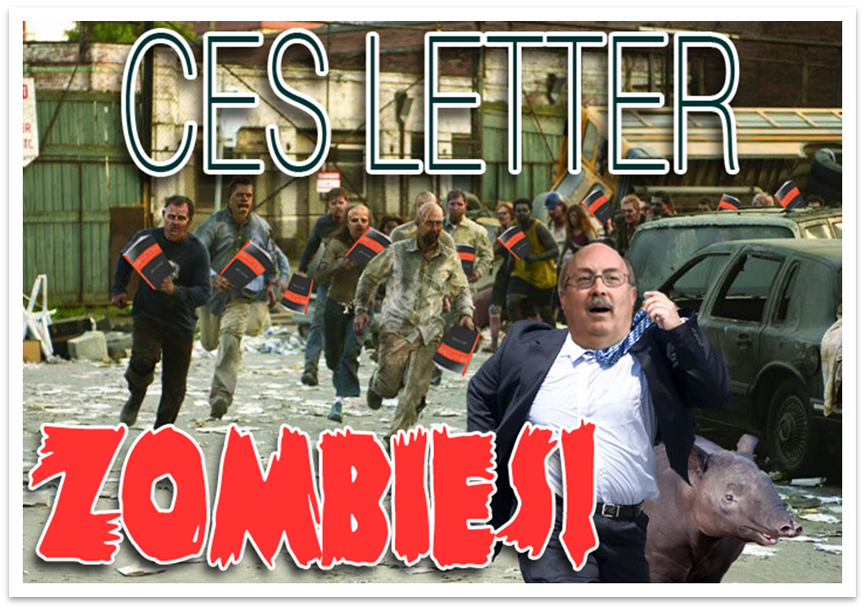
Peterson claims his audience is those who might read the CES Letter and then "jump ship too soon." He claims there are answers to just about every issue raised in the CES Letter and tells a story about a family that left the church based on inaccurate or incomplete information. He offered his audience a direct link to FairMormon's response to the CES Letter but not a peep anywhere in his entire presentation about my direct rebuttal to FairMormon's response: Debunking FairMormon.
The "those-who-leave-jumped-ship-too-soon-because-they-didn't-study-enough" argument and reasoning that Peterson employs is also used by Christian, Fundamentalist Mormon (FLDS, AUB, etc.), Islamic and Jewish apologists against their own apostates as well. This same argument and reasoning can also be used against those who reject the truth claims of cult leaders like Warren Jeffs, Marshall Applewhite, David Koresh, Sun Myung Moon, Chris Nemelka and L. Ron Hubbard.
But, I'm not really addressing him. I'm addressing people who might run into these things that are still puzzled by the charges that he makes. As I say, it's a kind of compendium, not original at all...not really pretending to originality. It's a compendium of charges and accusations. My impression and view of the bottom line is that the author spent too little time and effort looking at these questions, that he "jumped ship" too soon, that there are answers, at least adequate, and in some cases really much more than adequate to just about every issue raised.
Peterson conveniently completely ignores my Debunking FairMormon, which an extension and expansion of the CES Letter.
Peterson says: "As I say, it's a kind of compendium, not original at all...not really pretending to originality."
This is a really odd thing for Peterson to say. I never said to the CES Director, "Here are brand new and original issues and problems with the Church for you respond to." Instead, it was "Here are issues and problems with the Church that I have asked for answers to and no one is giving me any good official answers. Can you help me out here?"
The issue is not whether or not the problems are brand new or original. The issue is that these questions and problems are not being answered officially by the Church and its "prophets, seers and revelators." One of the big problems is that the unofficial "answers" given by unofficial apologists like Daniel C. Peterson and his buddies (FairMormon, et al.) not only contradict themselves but go against official Church teachings and doctrine. The "answers" given by Daniel C. Peterson and his buddies are no more official and legitimate than the opinions and pet theories of that weird old cranky guy in the High Priest quorum that no one listens to (every ward seems to have one).

Peterson says: "My impression and view of the bottom line is that the author spent too little time and effort looking at these questions, that he "jumped ship" too soon, that there are answers, at least adequate, and in some cases really much more than adequate to just about every issue raised."
Anyone who has read in its entirety Debunking FairMormon (close to 900 pages of content!), which Dan completely ignores in his presentation, knows that Peterson's claim that "the author spent too little time and effort looking at these questions" and that I "jumped ship too soon" and that "there are answers, at least adequate" is absurd nonsense.
Church Historian Elder Steven E. Snow contradicts Mormon apologist Daniel Peterson. Elder Snow's response to a 32-year-old member's questions and concerns over Church origins, history and current practices is a stark contrast to Peterson's swaggering "there are answers, at least adequate, and in some cases really much more than adequate to just about every issue raised" claim:
"You ask fair questions, and they are all questions for which we trust good answers exist, though we do not believe all the questions can be answered in this life in such a way that will eliminate the need for faith or trust, or that the answers will appear perfectly rational or convincing to all. For many of these questions, the best answer may be 'the historical record does not provide enough evidence to answer definitely.' This is not a dodge; it is the reality of the record."
- Elder Steven E. Snow, Church Historian
But I think of a case of my own youth in California. Some of you may remember a fairly obscure case that made it to the L.A. Times (as almost any anti-Mormon thing does), where three handwriting analysts had decided they had found...well, two of them had found, the writing of Solomon Spalding in the original manuscript of the Book of Mormon. It was an unidentified scribe. And there was a family in my stake that left the Church that week over that issue. Now the whole thing blew up within a week. The handwriting analysts who had made the claim: one of them never really endorsed it, one of them went silent, and the third one absolutely just said it was not true. So, it didn't make much of a splash really, but it was enough for this one family. They jumped ship too soon. I don't know, it almost seemed as if they were poised at the door waiting for a reason to leave. I didn't know them that well. I don't know what the story was, but let me read to you something that Jeff Lindsay had to say, sort of about this kind of thing, this motif of the letter. This is not the first one I've seen...it probably won't be the last, where you get a whole "shotgun blast" of objections.
Peterson continues his "blame the victim" attacks.
Peterson shares a story about a family in California who left the Church in a week over the "Spalding theory." In other words, "these folks were so shallow and ignorant as to throw away their eternal family and eternal salvation over this one single issue."
This really shows the mindset and heart of Daniel C. Peterson. Instead of saying something along the lines of "Wow, these folks must have had a ton of issues dating for years and we really didn't resolve them," Peterson sees a straw break a camel's back and blames the camel.
In the universe of Daniel C. Peterson, anyone who leaves the Church must be castigated as "wanting to leave." Peterson admits that he "didn't know them that well" and that he also does not "know what the story was" but he won't let this stop him from judging them. Peterson does not know me either. It's too bad that this does not stop Peterson from casting that family and me as weak, wanting to leave the truth and as fools in front of an audience.
Well, for this, and many other reasons, those who have been led by the Letter to a CES Director to abandon their faith, should, in my view, reconsider those Mormon claims and the abundant historical support that's available for them. They simply haven't studied enough.

CES Director: "Send me a list of your issues and concerns about the Church."
Jeremy Runnells: "Okay, here's my list. I'm hoping you're going to have better answers than FairMormon and unofficial apologists."
Daniel C. Peterson: "Big list! Shotgun blast of objections! Look at how one-sided the letter is. Nothing about my unofficial opinions and theories. No positive evidence for the Church. Author simply didn't study enough."
Peterson thinks those who "haven't studied enough" need to read the volumes of unofficial and contradictory sources he references in his presentation. When you look at Peterson's presentation footnotes, for example, you will find that 4 out of 8 of these sources are authored by none other than Daniel C. Peterson himself. The remaining 4 of the 8 sources contain 3 references to Mormon apologists and Peterson's own apologetic Interpreter Foundation organization that he founded after he got fired from Neal A. Maxwell Institute in 2012. Biased and narcissistic much?
When Peterson says "they simply haven't studied enough," he is really saying, "they simply haven't studied enough of my and my buddies' unofficial opinions and theories." They simply haven't "cherry-picked enough."
Again, anyone who has read in its entirety Debunking FairMormon (which Dan conveniently completely ignores in his presentation) knows that Peterson's claim that "the author spent too little time and effort looking at these questions," "jumped ship too soon," "there are answers, at least adequate," and that I "simply haven't studied enough" is absurd nonsense.
It is as if Peterson is offended that I dared not choose one of his and his buddies' contradictory, unofficial and illegitimate sources of knowledge and perceived authority to accept and believe. It is as if Peterson is offended that I dared bypass his Gospel of the Mormon Apologist® and refuse to recognize his priesthood in favor of seeking direct official answers from the Church of Jesus Christ of Latter-day Saints itself through its CES Director.
In Daniel C. Peterson's universe, you have to read just the right number of unofficial 800 page books written by unofficial apologists under just the right guidance and direction to be able to get "adequate" answers.
As one person observed:
"If it takes a Mormon apologist PhD level understanding of Mormonism to stay a believer, then the Church has bigger problems than I thought."
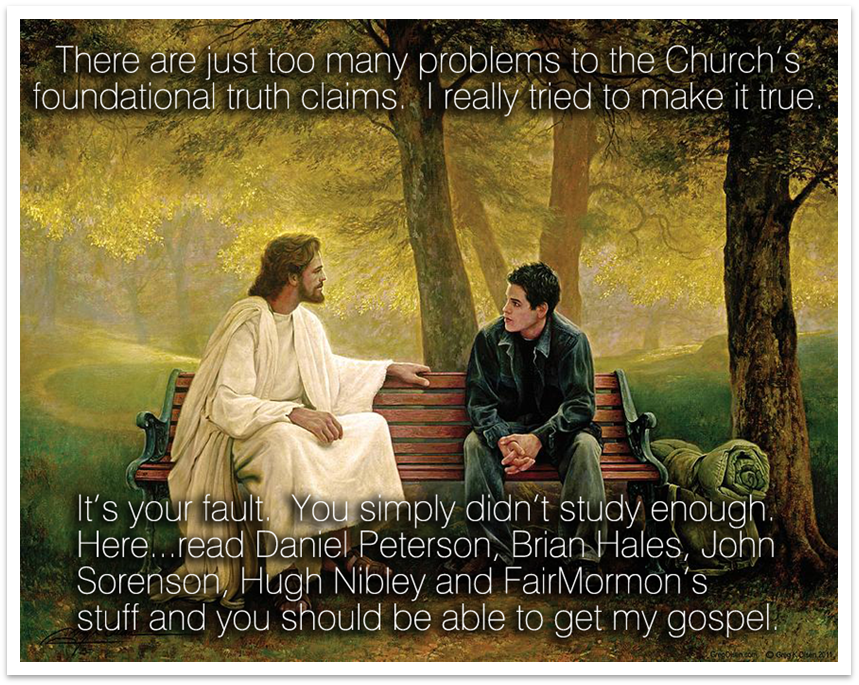
The CES director said that he would get back to him with answers, but he did not, according to the story. Now the thing is about 90 pages long, and it's just a ratta tat tat list of objections. I can understand why a normal person confronted by that would say, "Well, you know, I've got a life." In 90 pages of quick and dirty objections would take 500 pages to respond to, and probably wouldn't do much good, so, never mind.
Peterson starts his presentation based on incorrect assumptions and inaccurate understanding on the background and purpose of the CES Letter.
Fact: The CES Director told my grandfather after he had received, opened and read the CES Letter the following statement:
"It is a very well-written letter and I will be providing Jeremy a response."
If Peterson's assumption is true, why did the CES Director promise me a response after receiving, opening and reading the CES Letter?
Dan's entire reflection starts from the false premise that the response wouldn't do much good for me now but his entire presentation is directed at the people who are currently being impacted by my letter. These people deserve real answers to real questions and not just more mystical hand waving by Mormon apologists. Like me, they are also still waiting for an official response.
Peterson concedes that the CES Letter has "gotten quite a bit of circulation." Many folks have and are leaving the Church over the facts outlined in the CES Letter. So, it's no longer true that the CES Director's response "probably wouldn't do much good, so, never mind" as hundreds of thousands of people would be very interested in what the CES Director has to say to the issues and problems outlined in the letter. More especially so since the CES Director's official responses would hold far more weight and credibility than the opinions and theories of unofficial apologists.
The CES Director knows about the letter. The CES Director is aware of the impact of the CES Letter today and that - from the LDS perspective - it is influencing people away from the Lord's "one and only true Church." The CES Director's continued silence and lack of response, at least to me, is very telling and damning in itself.
Peterson continues on in his FairMormon presentation with other incorrect and false assumptions about me and the CES Letter.
I have to say, some people have said and speculated online that I'm addressing this topic out of my deep concern and paranoia. Well, I am sort of concerned about the letter and sense that it's had some impact, but it actually was not my idea to address it. Someone said, "You know, maybe you should address that. Maybe that would be a good topic." And I said, " 'Yeah, OK. I'll think about that,' and the next thing I knew, publicity was going out saying that's what I was addressing. So, I'm gonna do it. Why not? But I was asked to do it and I have to say my reaction to reading the thing, which I put off reading for a long time, was sadness and frustration. I found it very painful to go through the 90 pages. It is wearisome reading and that, point after point, multiple times at a page, I was exasperated. My impression is that the author is someone who had leanings in more of what you might call a fundamentalist direction than my own, but he was blindsided by things that he was learning about history and historical difficulties that he had not encountered before. He lost his trust and felt betrayed, and so he's in a position now, where anybody speaking on behalf of the Church is probably lying. And, so, you know, what I say today will not probably be of much value or interest except, so far as just makes him mad.
Got it, Dan. You're making sure everyone knows that you're just too smart and too important to deal with "that" CES Letter. It's just beneath you. But since "someone" asked you very nicely, you're going to go ahead and bestow to us all your grace and favor by getting off your horse to "address" that CES Letter.
Peterson says: "My impression is that the author is someone who had leanings in more of what you might call a fundamentalist direction than my own."
I will let one David take over this one:
"What the hell does Daniel Peterson mean? Does he mean that Jeremy Runnells was more devoted to prophets than Peterson? Is Peterson, as a BYU Professor, a closet apostate or a half-jack-Mormon? How is Peterson, as a hardcore apologist, not fundamentalist? I suppose I am clueless about the definition he's applying here."
Peterson says: "He lost his trust and felt betrayed, and so he's in a position now, where anybody speaking on behalf of the Church is probably lying. And, so, you know, what I say today will not probably be of much value or interest except, so far as just makes him mad."
The most important sentence in Peterson's entire presentation: "He lost his trust and felt betrayed".
This is why Mormons leave. When they discover the real history and the real Joseph Smith that the Church has concealed from them their entire lives? After being sold for years by the Church a counterfeit product with counterfeit rewards if they would surrender their time, money and obedience to the "Brethren"? Of course trust becomes completely lost and they feel betrayed. What kind of a weird psycho wouldn't? Once you have peeked behind the curtain to see the Church for what it truly is, there is no going back.
I'm personal friends with several Mormon apologists. They don't lie and, unlike Peterson, I give them the respect, decency and courtesy of not questioning their integrity and character because of their sincerely held beliefs.
There are good, sincere and honest members and apologists willing to acknowledge the problems and issues for what they are. They get why people leave the Church over these issues and unlike Peterson, they do not gaslight and employ "blame the victim" attacks to try to explain away or obfuscate the very real and serious challenges and problems to the Church's foundational truth claims.
What upsets me is that apologists like Daniel C. Peterson, Brian C. Hales and FairMormon are willing to use ad hominems and misrepresent me and attack my name, integrity and character in their desperate attempts to discredit the CES Letter
I welcome actual discussion and debate on the actual issues and problems raised in the CES Letter. I do not welcome outrageous personal ad hominem attacks and deliberate and blatant deception and misrepresentations.
I don't know what the story was, but let me read to you something that Jeff Lindsay had to say, sort of about this kind of thing, this motif of the letter. This is not the first one I've seen...it probably won't be the last, where you get a whole "shotgun blast" of objections.
One of the challenges, Jeff Lindsay writes, in defending one's faith, is coping with the critics who use the "big list" technique in their attack. This involves throwing out numerous arguments to create the impression of an overwhelming barrage that decimates the faith in question. The "big list" is loaded with barbed questions that weren't written in search of a real answer. If there is a good defense to the arguments raised at first...never mind, there are many more to be launched in different directions. As with many topics in fields like history, science and religion, the issues raised in "big list" attacks are often complex and may require exploring abundant details to answer questions properly.
Even for those who are prepared to answer questions on a wide variety of topics, the time it takes to lay a foundation to properly answer a question can be taken by the instantly impatient critics as an admission of weakness and confirmation that they are right, and then the time to move on to the next attack, and the next. If reasonable answers are promptly provided to some attacks, or if the alleged weakness on further examination actually proves to be evidence in favor of the faithful position, the response can be ignored as new attacks from the "big list" are hurled out.
Lindsay cites a well-known science blogger by the name of P.Z. Meyers, who is himself is not religious at all. He is an aggressive atheist, but he makes a good point. Meyers says:
There is a common tactic used by creationists, and I've encountered it over and over again. It's a form of the "Gish Gallop." It's named after Duane Gish, who's a famous Creationist Fundamentalist Protestant. Present the wicked evolutionist with a long list of assertions, questions and non-sequiters, and if they answer with, "I don't know" to any of them, declare victory. It's easy: We say, "I don't know" a lot.
Jack Chick's "Big Daddy" tract is a version of the Creationist list and contains a fair amount of fantasy as well. You know what they believe will happen: They'll ask that one question that the scientists can't answer, and then they'll have an epiphany, a revelation, and realize that all of their science is a lie, at which time they'll resign from their university position and join a good, Bible-believing church.
It happens to me all the time too. At one talk I gave, there was a woman at the door who had printed a five-page, single spaced list of questions, and she was telling everyone going in to ask me to answer them. I invited her to come in and listen to the talk and ask them herself, and she ran away. I've had a Canadian Creationist do the same thing, and then I talked to him for several hours in the hallway after the talk. He seemed stunned and angry that I actually had answers for most of his questions. I've been confronted by people with questions, more like ignorant assertions, about biology, who, once I answered them and revealed that I am a biologist, switched to asking me about geology and the "Big Bang" to get me into a corner where I would have to say, "I don't know."
The approach, Jeff Lindsay says, is painfully familiar to him, and I have to say it's painfully familiar to me too.
It is pretty rich for a religious apologist such as Peterson to even try to seat himself among the same scientists who have to "painfully" deal with religious fundamentalists like Peterson. I can point to actual scientists in the fields of archaeology, anthropology, molecular biology and egyptology who get migraines from dealing with Daniel C. Peterson himself. Oh, and, by the way Dan, the creationists called...you're on the wrong team.
Peterson is taking out the well-worn apologetic card of misapplying logical fallacies. The "big list" or "Gish Gallop" that Peterson refers to is a tactic used in debates to drown out reasoned response because there's a time limit. The shotgun approach is effective at giving an opponent too much to address in their allotted time, and it gives the impression that the attacker has "won" because the response is lacking.
Peterson is incorrect that the CES Letter takes any such approach. The internet is not a formal debate club and Mormon apologists do not have a time limit.
The CES Letter is not a Gish Gallop as it's a list in written form of grievances, questions and concerns to a CES Director who, by the way, requested them. The CES Letter is not a Gish Gallop as there is no time limit to respond to it. Once again, Peterson misrepresents the CES Letter, its background story and its purpose.
The CES Letter is a "big list" because the CES Director requested the list of reasons why I no longer believe in the LDS Church's truth claims. I was not trying to win a debate nor did I think I was in a debate with the CES Director when I wrote the letter. The CES Director asked me to lay down my concerns on the table so I did exactly just that. I wanted his official answers. For Peterson and other Mormon apologists to claim that the letter is a "big list" is more of a testament of their fundamental misunderstanding of the CES Letter's background story and purpose than it is that the CES Letter is a "big list."
CES Director: "Give me a list of your issues and concerns about the Church."
Jeremy Runnells: "Sure, here's my list."
Dan Peterson, Jeff Lindsay and FairMormon: "Big List! Gish Gallop! Big List Attack on the Church."
The apologists and the CES Director are not being drowned out and have had plenty of time to respond to each issue. In fact, FairMormon did an "analysis" of the CES Letter on their website. I have responded to FairMormon in my Debunking FairMormon, which can be viewed here. Peterson very conveniently completely ignores Debunking FairMormon in his entire presentation.
What's ironic is accusing the CES Letter of Gish Gallop and "Big List" attack when FairMormon's and Jeff Lindsay's websites can be accused of the exact same thing.
Peterson's Gish Gallop assertion is ridiculous. The CES Letter has been online since April 2013. Debunking FairMormon has been online since February 2014. FairMormon has set up their response to the CES Letter. For Peterson to stand up at his FairMormon podium in August 2014 and hand wave away the letter and complain that he doesn't have enough time to respond to all of the issues while yelling "Gish Gallop!" and "Big List!" are just cheap shots.
John Dehlin in his discussion with a Mormon apologist shares his view of apologists using this disingenuous attack against the CES Letter:
There is no such thing as Gish Gallop online. The internet is open 24 hours a day 7 days a week. Take all the time you need, Dan.

There have been some excellent responses. One of these is the FairMormon site, on the FairMormon wiki, and I have to say, I am tremendously impressed with the amount of work that the wiki has done (Roger Nicholson and Greg Smith, in particular), in developing answers and in making it accessible and in organizing answers to this and other objections. It's a tremendous thing. FairMormon does incredible work on a shoestring budget. I mean, it's astonishing, and with relatively little more (I'll put in that plug, even though we have reached the fundraising goal for today). With just a little bit more, FairMormon could do much, much more, because it's a very lean and efficient operation.
I agree that FairMormon mostly did a wonderful job in showing that they, assuming that FairMormon's undisputed silence is acceptance of the facts, agree with 79% of the CES Letter.
I highly encourage folks to read FairMormon's original responses to the issues raised in the CES Letter before they revised, censored, deleted and altered their original responses after I published Debunking FairMormon: cesletter.org/debunking-fairmormon
Kevin Christensen wrote a piece for Volume 10 of Interpreter (another organization that could use donations), entitled, "Eye of the Beholder, Law of the Harvest", which is an analysis of Jeff Lindsay's approach and the author of the CES Letter's approach, and explains how they arrive at so different conclusions to looking at the same data.
Peterson's friend and fellow Interpreter Foundation Mormon apologist Kevin Christensen's hit piece on me is beyond asinine and obnoxious.
Click on the image below to see our response and debunkings of Kevin Christensen and his pieces:
I'm going to go through a few of the issues. The thing is 90 pages long, and I've only got a few minutes. In fact, I have very few minutes. I'm going to try to get you out of here close to on time, but I don't know if I can do it, to be honest.
Peterson is using the same parlor trick that assistant Church Historian Richard Turley, Jr. used in the infamous Swedish Fireside where Turley claimed to have answers to the issues and problems but kept using the clock as an excuse for actually not answering the issues and problems.
It is ridiculous to select a forum, where you know in advance that the time is limited, to turn around and complain at the podium that you cannot sufficiently answer the questions and problems because your time is limited. FairMormon Conference ran for two days and one of the sponsors of the conference was Interpreter Foundation, Peterson's own organization. Peterson, as a top Mormon apologist, could have demanded and received all of the time he needed and wanted to sufficiently respond to the issues and problems raised in the CES Letter. Faithful Mormons genuinely struggling with doubts and questions deserve much better than the hand waving "I'm out of time" presentation they instead got from Peterson at the conference.

DNA and the Book of Mormon is one issue that he addresses. He says this:
"DNA Analysis has concluded that native American Indians do not originate from the Middle East, or from Israelites, but rather from Asia."
Now that is a grotesque oversimplification. He simply doesn't know the state of the question. It is true that DNA evidence indicates that the American Indians overwhelmingly have some sort of Northeastern Asian background, but that does not rule out the presence of a small group. We're talking a tiny group from the Middle East, 2600 years ago.
Notice that Peterson does not say that my CES Letter statement and claim is false or incorrect. Rather, it's a "grotesque oversimplification."
Again, Peterson completely ignores Debunking FairMormon where I expand and elaborate on the DNA issue here. Peterson complains that the letter is too long but then gripes that my statements are a "grotesque oversimplification."
The money part of Peterson's above statement is his concession that "it is true that DNA evidence indicates that the American Indians overwhelmingly have some sort of Northeastern Asian background" but then Peterson has to go against 180 years of Church teachings and claims by "prophets, seers, and revelators" along with the Book of Mormon itself that this "tiny group" integrated into an established native population that had immigrated from Asia thousands of years before Adam and Eve showed up. In other words, "And behold, it is wisdom that this land should be kept as yet from the knowledge of other nations; for behold, many nations would overrun the land, that there would be no place for an inheritance" really does not mean just that.
"Prophet, seer and revelator" Spencer W. Kimball was just "speaking as a man" when he made these claims.
This so-called "tiny group" grew into millions of Nephites/Lamanites - who rivaled the Roman Empire in numbers. Peterson and now the Church (through its new Book of Mormon and DNA Studies essay reversing 180 years of past prophetic teachings) want you to believe that this "tiny group" assimilated and integrated into an existing native population that came from Asia through the Bering Strait thousands of years before Adam and Eve and thus Lehi's "tiny group" DNA became diluted over time, which is why we do not see Middle Eastern markers in the DNA record of Native Americans.
Elder Jeffrey Holland's printed Ensign "A Promised Land" contradicts this idea:
"Holy scripture records that "after the waters had receded from off the face of this land it became a choice land above all other lands, a chosen land of the Lord; wherefore the Lord would have that all men should serve him who dwell upon the face thereof." (Ether 13:2.) Such a special place needed now to be kept apart from other regions, free from the indiscriminate traveler as well as the soldier of fortune. To guarantee such sanctity the very surface of the earth was rent. In response to God's decree, the great continents separated and the ocean rushed in to surround them. The promised place was set apart. Without habitation it waited for the fulfillment of God's special purposes.
With care and selectivity, the Lord began almost at once to repeople the promised land. The Jaredites came first, with stories of the great flood fresh in their memories and the Lord's solemn declaration ringing in their ears: "Whoso should possess this land of promise, from that time henceforth and forever, should serve him, the true and only God, or they should be swept off when the fullness of his wrath should come upon them." (Ether 2:8.)
The Nephites/Lamanites have disappeared from the DNA landscape along with their buildings, steel, shields, weapons, coins, horses and chariots.

This is another statement he makes:
"Why did the Church change the following section of the introduction page of the 2006 edition of the Book of Mormon shortly after the DNA results were released?" Quote: "The Lamanites were the principal ancestors of the American Indians" is changed to, "The Lamanites, and they are among the ancestors of the American Indians."
Well, the implication is because the DNA evidence undercut the Church's position. That's not true. I happen to know the backstory, which has never been published. The backstory is, there were people who objected to that heading when it was done in the late 1970s/early 1980s. They were overruled by someone who was in a position of authority. But, they said the Book of Mormon never actually makes that claim. Don't make the Book of Mormon claim things it doesn't actually claim. We set ourselves up sometimes for problems when we claim things for the book, but that the book, when carefully read, does not claim for itself.
Unfortunately for Peterson, the Church's own spokesman contradicts Peterson's claim.
In a 2007 Deseret News article on this topic, Church Spokesman Mark Tuttle made the following comment when asked why the change occurred:
"[Last year's changes] 'takes into account details of Book of Mormon demography which are not known.'"
In other words, per Church spokesman Tuttle, we're making the change because of Book of Mormon demographics which due to new DNA data "are not known."
Tuttle was asked specifically about who wrote and added this text in 1981 and he declined to comment on who the individual(s) was.
Even if Peterson's unpublished "backstory" is true (since all we have is his claim), it does not change or alter the facts nor does it make my CES Letter statement on the DNA issue incorrect or "not true."
Fact: DNA test results, as Peterson concedes, establish that "the American Indians overwhelmingly have some sort of Northeastern Asian background" and these results started pouring in and being published in the late 1990s all the way up leading to and beyond 2006, when the change in the Book of Mormon occurred. In fact, there was a Los Angeles Times article published in February of 2006 on the very issue of the Book of Mormon being contradicted by the DNA evidence.
Whether or not there was an internal debate in the 1980s on the introduction page wording as shown below is irrelevant as the Church published its claim in the Book of Mormon and the Church changed the wording at just around the time when the DNA evidence against the Book of Mormon was being established in both the lab and the public square. Again, the Church's own spokesman confirmed in 2007 that the change was made due to new information on demography (aka DNA).
Let's recount exactly what I state in the CES Letter:
DNA analysis has concluded that Native American Indians do not originate from the Middle East or from Israelites but rather from Asia. Why did the Church change the following section of the introduction page in the 2006 edition Book of Mormon shortly after the DNA results were released?
"...the Lamanites, and they are the principal ancestors of the American Indians"
to
"...the Lamanites, and they are among the ancestors of the American Indians"
My above CES Letter statement still stands as factually correct.
Now, I'm going to use this as a symbol for the kind of work that's being done right now, and has been done over the past few decades, on Book of Mormon archaeology. This is John Sorenson's book, Mormon's Codex. I'm not saying that it's the "be all" and "end all," but it kind of represents the effort that professionally-trained Mesoamericanists have made recently.
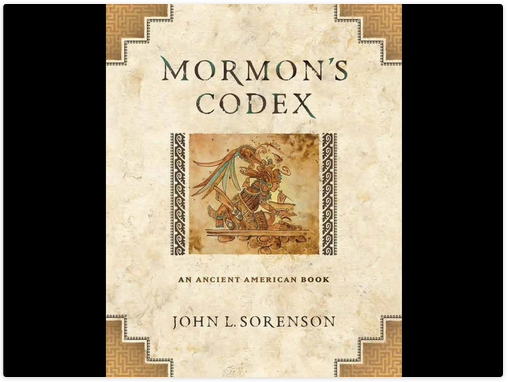

I was hoping that Peterson was going to give us credible and accessible sources such as non-Mormon archaeologists/anthropologists, non-BYU peer-reviewed papers and the findings of non-Mormon respected institutions and organizations such as the Smithsonian Institute and National Geographic instead of telling us to check out his fellow Mormon apologist John Sorenson's $53 eight-hundred page book at Deseret Book.
Is this really what the gospel of Jesus Christ has come down to? To get "answers" to serious stumbling blocks of faith, we have to dive into mysterious, entangled and complicated unofficial apologetics - under just the right sources and guidance, of course - in hopes of making it all somehow fit? That we have to buy a $53 eight-hundred page book from Deseret Book?
As one person observed:
"If it takes a Mormon apologist PhD level understanding of Mormonism to stay a believer, then the Church has bigger problems than I thought."
The second issue that he raises is the issue of anachronisms He says,
"Horses, cattle, oxen, sheep, swine, goats, elephants, wheels, chariots, wheat, silk, steel, and iron did not exist in pre-Columbian America during Book of Mormon times."
Again, this is an oversimplification. There's been a lot written on these sorts of topics, and many of them by John Sorenson (one of the reasons I chose this image) [refers to Power Point slide]. But the author of the letter seems unaware of those things. He doesn't engage them in any event. I can imagine someone saying "the evidence doesn't persuade me," but what bothers me is to suggest there is no evidence, that there are no counterarguments; "that bothers me, and that doesn't", to me, show a serious engagement with the data.
Notice that Peterson does not say that this is false or incorrect. Rather, it's an "oversimplification."
This is Mormon Apologetic Speak for:
"Yes, these are anachronisms but we're not going to straight up tell you they're anachronisms because we're going to spin and stretch stuff to make things appear probable (example: horse can be a tapir or deer instead) in hopes of making you forget they are anachronisms to begin with. Now, go buy Mormon apologist's John Sorenson's 800-page Mormon Codex! Only $53 at your nearest Deseret Book!"
Think about it. If there really was solid - or even somewhat good - evidence that there were elephants or horses or steel (or insert X Book of Mormon anachronism here) in Pre-Columbian Americas, you would not be getting this runaround from Daniel Peterson. Truth is simple, transparent and clear. All Peterson would have to say is, "Jeremy is incorrect. For example, there were elephants and horses and steel (or insert X Book of Mormon anachronism here) in Pre-Columbian Americas and here is the (insert non-fellow Mormon apologist and non-BYU peer-reviewed data) evidence to back it up."
But there isn't evidence to back it up. Respectable non-Mormon archaeologists / anthropologists / scholars reject Peterson and his fellow Mormon apologists' claims. This is why Peterson and his fellow Mormon apologists have to point to each other and high-five each other as sources while respectable non-Mormon scholars in the fields of archaeology and anthropology (and egyptology, astronomy, biology, etc.) laugh about these apologists' claims around the water cooler.
As one individual who read Peterson's article wrote:
"How much study does it take? Surely abundant historical support could all be mentioned within Peterson's 11,311 words on the topic. If not, how much more time does he need? And why was he giving weird analogies about hypothetical negative reports instead of discussing the hard evidence to support his position? Peterson tries to sound smart by mentioning 'materialist metaphysics of Mormon thought,' 'progressive deification,' 'precursors of the Augustinian doctrine,' and 'heresy par excellence' all within ten lines. Facts and evidence could be plainly stated. Either the letter is wrong about the facts or it is not. Peterson dodges the issues nearly entirely in his speech."
Despite Peterson's ad hominem attack and attempts to portray me as clueless on Mormon apologetics, I am very well versed in apologetic defenses on this topic along with the rest. Researching and responding to Mormon apologists and apologetic claims has consumed my life the past few years. Debunking FairMormon (which contains about 900 pages of content!) and my other responses to Mormon apologists is evidence of this. Of course, Peterson completely ignores this in his presentation as it directly contradicts Peterson's premise that Jeremy is a bumbling idiot who is clueless on Mormon apologetic defenses and "scholarship."
Again, it's the answers and reasoning given by apologists like Peterson and his buddies (including FairMormon) that has contributed to the obliteration of my testimony and it was from this environment that I had the need and desire to write the letter to the CES Director for official answers to begin with. Peterson again demonstrates his lack of understanding of the CES Letter, its background story and its purpose.
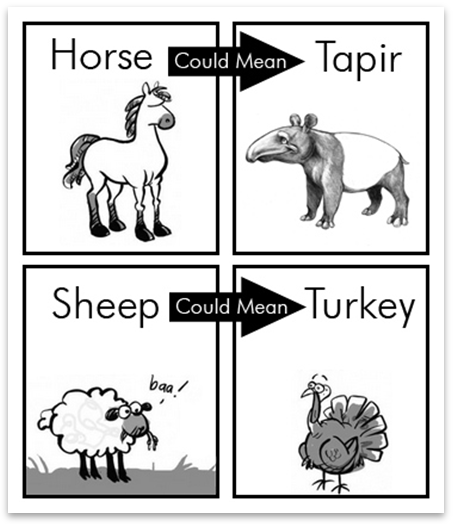
The third item is archaeology:
"There is absolutely no archaeological evidence to directly support the Book of Mormon or the Nephites/Lamanites who numbered in the millions."
Note that word "directly." Archaeology very often doesn't "directly" support claims. You often are having to draw inferences from the data. You know, the rocks in the foundations of buildings don't speak for themselves usually, and there are relatively few inscriptions. I mean, even Jerusalem itself, we've known from tradition where is was located, but it was only relatively recently that an inscription was found actually identifying that city as Jerusalem. So, there are limits to archaeology. But again I mention John Sorenson, the writing of John Clark, Brant Gardner, Mark Wright. If the author of the letter has dealt with them there's no sign of it. I don't see any evidence that he's engaged them.
Notice that Peterson does not say that my claim of no archaeological evidence for the Book of Mormon is false or incorrect. Rather, Peterson doesn't like my use of the word "directly" and spends his time focusing on this instead of actually outlining actual Book of Mormon archaeological evidence to prove me wrong.
When critics state that there is absolutely no evidence to directly support the Book of Mormon or the Nephites/Lamanites who numbered in the millions, they're saying:
"There is no location that matches multiple items/technology/animals that the Book of Mormon states should be found in the time period specified. Examples of these items/technology/animals would be gold, steel, swords, horses, elephants, etc. Scientists are not necessarily just looking for names of people or places that are similar to ones in the Book of Mormon - just evidence of a culture that matches Book of Mormon claims."
There is a reason why world renowned archaeological and anthropological institutions such as the Smithsonian Institute and the National Geographic Society reject the Book of Mormon as a historical record and have officially stated that there is no archaeological or anthropological evidence to support the book and its claims.
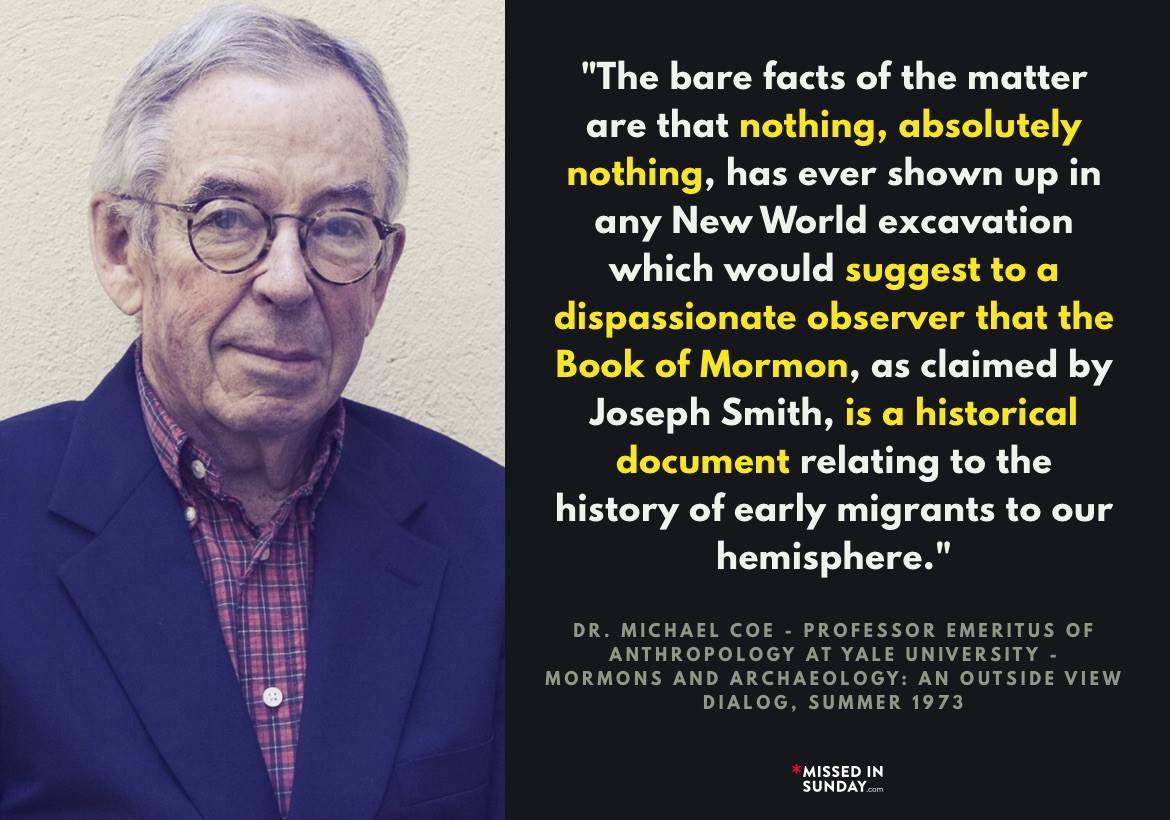
World renowned archaeologist and anthropologist Dr. Michael Coe, who has focused extensively on researching pre-Columbian Mesoamerica, has consistently rejected the historical claims of the Book of Mormon throughout his life. He has done several interviews focusing directly on this topic, which can be found here.
If the Book of Mormon is historical and the geography, for example, is real, then it is not unreasonable for Mormon scholars to put together - based on the data - of a potential location of one single Book of Mormon land. It is not unreasonable to then publish for peer-review this data in a non-Mormon journal that is not BYU-controlled. It is not unreasonable to have other archaeologists, anthropologists and other experts to peer-review the data. This is the scientific process which was used to find the lost city of Troy. This is the same scientific process that can lead to the discovery of Zarahemla. Unfortunately for the Church and its apologists, decades of vigorous archaeological and anthropological research have yielded nothing.
This is also the same scientific process that was used to find a thousand-year-old Viking outpost in Canada. Quite frankly, it is beyond ridiculous that we can find a tiny Viking outpost in Canada which consisted of a very small group of people who landed a thousand years ago in a very remote part of the Americas but we cannot find a trace of massive Nephite/Lamanite/Jaredite civilizations which numbered in the millions. It's insane that a civilization roughly the size of the Roman Empire, spanning a time frame of 1,000 years, just completely vanished into thin air without a trace. The Romans left roads, aqueducts, coins, buildings, independent historical accounts, etc. all over Europe and the Mediterranean.
Where is the evidence for the Nephite and Lamanite civilizations?
He says this:
"This is one of the reasons why unofficial apologists* are coming up with the Limited Geography Model. It happened in Central or South America, and that the real hill Cumorah is not in Palmyra, New York, but is elsewhere and possibly somewhere down there instead."
* (That's people like the old FARMS or FAIR now)
This is simply not true. The Limited Geography Model has been created because the Book of Mormon demands it. You can put together all the travel distances and travel times in the Book of Mormon and it's very clear that they're not going far in any direction. We're not talking about Patagonia to the Aleutian Islands. It's simply not possible. And so, the text forces this. This sort of thing has been in the works for a long time, before there was any talk about DNA, before the discovery of the DNA double-helix model. DNA was not an issue when this was being created. This is not controversial. It can easily be shown that the limited Mesoamerican model has been in the works for decades. It just wasn't published until the 1980s, but it existed and was distributed in a kind of summarized underground form for a long time before it was actually published.
Peterson says: "This is simply not true. The Limited Geography Model has been created because the Book of Mormon demands it."

Hemispheric Mormon Apologist Rod Meldrum & FIRM Foundation

Limited Geography apologists are going against Joseph Smith and 180 years of teachings from the Church and its "prophets, seers and revelators" on this topic.
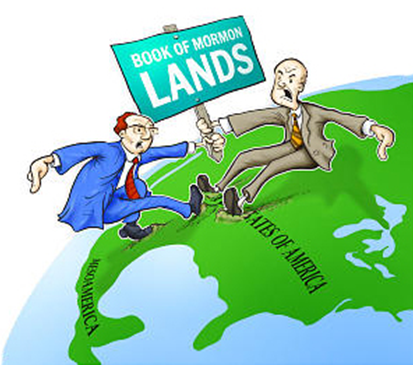 Peterson yet again does not show the bigger picture or the counterarguments. Not only does Peterson fail to show the weaknesses of his Limited Geography Model but he does not disclose that there is currently a war between Mormon apologists on this topic. You have apologists like Rod Meldrum (above picture), Bruce Porter and the LDS FIRM Foundation who reject the Limited Geography Model and embrace what they call the "Heartland Model" (North America only). Then, of course, you have apologists like John Sorenson, Daniel Peterson and FairMormon who embrace the Limited Geography Model (Mesoamerica).
Peterson yet again does not show the bigger picture or the counterarguments. Not only does Peterson fail to show the weaknesses of his Limited Geography Model but he does not disclose that there is currently a war between Mormon apologists on this topic. You have apologists like Rod Meldrum (above picture), Bruce Porter and the LDS FIRM Foundation who reject the Limited Geography Model and embrace what they call the "Heartland Model" (North America only). Then, of course, you have apologists like John Sorenson, Daniel Peterson and FairMormon who embrace the Limited Geography Model (Mesoamerica).
For Daniel Peterson to go up there on that podium and point to his Limited Geography Model as the "one and only true model on the face of the earth" without disclosing its problems, controversy and inconclusive consensus is incredibly disingenuous.
Peterson says: "This is not controversial. It can easily be shown that the limited Mesoamerican model has been in the works for decades. It just wasn't published until the 1980s, but it existed and was distributed in a kind of summarized underground form for a long time before it was actually published."
This is false. The Limited Geography Model is controversial.
Unlike unofficial apologetic attempts to rewrite Mormon history and the Book of Mormon along with overriding the teachings of Joseph Smith and prophets, Joseph Smith and the Church have taught the Hemispheric Geography Model rather than the fringe Limited Geography Model.
The numerous problems that a Limited Geography Model (Book of Mormon took place in a small pocket of Mesoamerica) creates:
"In this important and interesting book the history of ancient America is unfolded, from its first settlement by a colony that came from the Tower of Babel at the confusion of languages to the beginning of the fifth century of the Christian era. We are informed by these records that America in ancient times has been inhabited by two distinct races of people. The first were called Jaredites and came directly from the Tower of Babel. The second race came directly from the city of Jerusalem about six hundred years before Christ. They were principally Israelites of the descendants of Joseph. The Jaredites were destroyed about the time that the Israelites came from Jerusalem, who succeeded them in the inheritance of the country. The principal nation of the second race fell in battle towards the close of the fourth century..."
"I was also informed concerning the aboriginal inhabitants of this country [America] and shown who they were, and from whence they came; a brief sketch of their origin, progress, civilization, laws, governments, of their righteousness and iniquity, and the blessings of God being finally withdrawn from them as a people, was [also] made known unto me; I was also told where were deposited some plates on which were engraven an abridgment of the records of the ancient prophets that had existed on this continent."
Thus, supporters of the Limited Geography model can't argue that Joseph Smith misunderstood where the events of the Book of Mormon happened. To do so would be to argue that the angel Moroni lied to Joseph about these events.
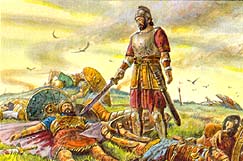
As mentioned above, Mormon apologists are currently warring with each other over hemispheric vs. limited geography. Limited geography apologists cannot even agree on the location or even its compass direction. Here are just a few examples of the different proposed Limited Geography Maps, just to illustrate the lack of consensus among "Limited Geography" apologists:
Another claim:
"Latter-day Saint Thomas Stuart Ferguson was BYU's archaeology division (New World Archaeological Foundation) founder. NWAF was financed by the Church. NWAF and Ferguson were tasked by BYU and the Church in the 1950's and 1960's to find archaeological evidence to support the Book of Mormon."
And the idea is, well, Ferguson failed and Ferguson lost his testimony, and this should discredit the Book of Mormon in the minds of alert, sentient Latter-day Saints. But that statement is wrong on multiple levels. Thomas Stuart Ferguson, for whatever virtues he had, was a lawyer and an amateur hobbyist. He was not the head of the archaeology program at BYU. And the NWAF (I've actually written an article on this), based on interviews with the founders and with early leaders, and so on, and it's been published. I mean, there's no excuse for this. NWAF had non-Mormons on its board. It was mostly non-Mormons. It was specifically forbidden to seek to do explicit Book of Mormon research. It was tasked with working in an area where Latter-day Saints expected it would find evidence, but it was not its task to do that. This is just completely wrong, and Ferguson's apostasy, whatever it was, his family disputes it. I don't know exactly what the truth of his mindset was at the end of his life. It may be sad, but it has no significance. And, at the same time, M. Wells Jakeman was an archaeologist, the first trained archaeologist, as far as I know, in the Church, who specialized in Mesoamerican studies. Why doesn't anybody write about his biography? He was fascinated...believed to his dying day that the Book of Mormon fit into Mesoamerica brilliantly well.
I break down Peterson's above statement below.
Peterson says: "And the idea is, well, Ferguson failed and Ferguson lost his testimony, and this should discredit the Book of Mormon in the minds of alert, sentient Latter-day Saints. But that statement is wrong on multiple levels."
No, the idea is that Ferguson, a staunch believer in Mormonism and the Book of Mormon, started out really believing that he and NWAF were going to find archaeological evidence supporting the Book of Mormon and after trying and working for decades of his life along with his NWAF team (which included trained archaeologists) to look for any evidence for the Book of Mormon, they never found archaeological evidence. It was only after all this time and effort that allowed Ferguson the courage to start asking himself the hard questions about the foundational truth claims of the LDS Church.
Peterson says: "Thomas Stuart Ferguson, for whatever virtues he had, was a lawyer and an amateur hobbyist."
This is Peterson's attempt to diminish and discredit Ferguson's influence and contributions to NWAF and the archaelogy program at BYU.
Yes, Ferguson did not have a degree in archaeology but it was a passion of his and he surrounded himself with archaeologists for decades of his life as he worked with and collaborated with archaeologists in both on the field and off the field to find archaeological evidences for the Book of Mormon.
Ironically, Peterson himself acknowledges Ferguson's dedication to the archaeological NWAF and the cause:
"Devoted to his task, he traveled throughout California, Utah, and Idaho; wrote hundreds of letters; and spoke at firesides, Rotary Clubs, Kiwanis Clubs, and wherever else he could. After a tremendous amount of dedicated work, he was able to raise about twenty-two thousand dollars, which was enough for the first season of fieldwork in Mexico." - Daniel C. Peterson, FARMS Review On the New World Archaeological Foundation
Peterson's double standard and hypocrisy is clearly on display in his attack on Ferguson. Peterson has no problem pointing to and passing off himself and others as experts in subjects that he and others are neither professionally trained nor hold degrees in. When the message is pro-Mormon and supports Peterson's conclusions? "Eh, who cares?" When the message is against Mormonism and contradicts Peterson's conclusions? He was just an "amateur hobbyist."
Peterson says: "He was not the head of the archaeology program at BYU. And the NWAF (I've actually written an article on this), based on interviews with the founders and with early leaders, and so on, and it's been published. I mean, there's no excuse for this. NWAF had non-Mormons on its board. It was mostly non-Mormons."
I never claimed that Ferguson was the "head of the archaeology program at BYU." This is a strawman and misrepresentation on the part of Peterson as I wrote in the CES Letter: "Latter-day Saint Thomas Stuart Ferguson was BYU's archaeology division (New World Archaeological Foundation) founder."
Here is my entire statement on this topic in the CES Letter:
Latter-day Saint Thomas Stuart Ferguson was BYU's archaeology division (New World Archaeological Funding) founder. NWAF was financed by the Church. NWAF and Ferguson were tasked by BYU and the Church in the 1950s and 1960s to find archaeological evidence to support the Book of Mormon. This is what Ferguson wrote after 17 years of trying to dig up evidence for the Book of Mormon:
"...you can't set Book of Mormon geography down anywhere - because it is fictional and will never meet the requirements of the dirt-archaeology. I should say - what is in the ground will never conform to what is in the book."
- Letter dated February 2, 1976
Despite Peterson's incredibly disrespectful dismissive hand waving attempt to diminish Thomas Stuart Ferguson's influence, accomplishments and legacy on the archaeology program at BYU, Mormon archaeologist Fred W. Nelson disagrees and wrote:
"Thomas Ferguson has either directly or indirectly influenced thousands of people's thinking on archaeology...He has had a great influence on professional archaeology through the Department of Archaeology at Brigham Young University, the Gates Collection, and the New World Archaeological Foundation...Ferguson's legacy in the founding of the Archaeology Department at Brigham Young University, the obtaining of the Gates Collection, and as Founder of the New World Archaeology Foundation stands as a shining example to us all. - The Messiah in Ancient America, p.282-283
I read Peterson's NWAF review article and do not find anything in his article that contradicts my CES Letter position and claims other than Peterson's desperate attempt to disassociate and disconnect the Church's involvement in NWAF as well as the NWAF being a Book of Mormon apologetic organization.
Fact that even Peterson concedes in his article: After Ferguson presented his case to the First Presidency itself on April 9, 1953, the First Presidency granted $15,000 to Ferguson and the NWAF. [$15,000 in 1953 is equivalent of $133,625 in 2014 US dollars]
The Church paid more money to the NWAF but Peterson fails to acknowledge this in his article. Peterson spills a considerable amount of ink in his article attempting to diminish and distance the Church's and First Presidency's direct involvement in the NWAF despite the above undisputed fact. In Peterson's universe, a Mormon asking the First Presidency itself for help in funding NWAF's archaeological fieldwork and the First Presidency directly giving Ferguson the equivalent of $133,000 is just the First Presidency using Church funds to further the cause of science and education and has nothing remotely to do with the Book of Mormon, seeking evidence for it and defending it.
Peterson says: "and Ferguson's apostasy, whatever it was, his family disputes it. I don't know exactly what the truth of his mindset was at the end of his life. It may be sad, but it has no significance."
Of course Ferguson's family disputed Ferguson's disbelief in the Church's truth claims. He was a closeted unbeliever. This was at a time when leaving the Church was really social suicide. Ferguson's disbelief is well documented as his private letters have since gone public after Ferguson's death. In fact, the following words of his demonstrate that Ferguson chose to hide his disbelief from his family and friends:
"...Mormonism is probably the best conceived myth-fraternity to which one can belong.... Joseph Smith tried so hard he put himself out on a limb with the Book of Abraham, and also with the Book of Mormon. He can be refuted - but why bother... It would be like wiping out placebos in medicine, and that would make no sense when they do lots of good...
"Why not say the right things and keep your membership in the great fraternity, enjoying the good things you like and discarding the ones you can't swallow (and keeping your mouth shut)? Hypocritical? Maybe...thousands of members have done, and are doing, what I suggest you consider doing. Silence is golden - etc...So why try to be heroic and fight the myths - the Mormon one or any other that does more good than ill?
"Perhaps you and I have been spoofed by Joseph Smith. Now that we have the inside dope - why not spoof a little back and stay aboard? Please consider this letter confidential - for obvious reasons. I want to stay aboard the good ship, Mormonism - for various reasons that I think valid. First, several of my dearly loved family members want desperately to believe and do believe it and they each need it. It does them far more good than harm. Belonging, with my eyes wide open is actually fun, less expensive than formerly, and no strain at all...I never get up and bear testimony...You might give my suggestions a trial run - and if you find you have to burn all the bridges between yourselves and the Church, then go ahead and ask for excommunication. (The day will probably come - but it is far off - when the leadership of the Church will change the excommunication rules and delete as grounds non-belief in the 2 books mentioned and in Joseph Smith as a prophet etc...but if you wait for that day, you probably will have died. It is a long way off - tithing would drop too much for one thing...
"Kindly do not quote this letter and please do not cite me."
Source: Scan of Ferguson's letter #1 & #2
It does have significance that a man who spent decades of his life trying to prove the authenticity and historicity of the Book of Mormon ended up spending the remaining decades of his life opposed to the Book of Mormon and Mormonism's truth claims while working to educate others on the evidences against both.
I am sympathetic to both Ferguson and his family. Ferguson discovered the problems of Mormonism in an era where he was damned if he did and damned if he didn't. He chose to not go public with his doubts in his desire to preserve his family and the family paid a price for this after his death.
In yet another example of hypocrisy, Peterson complains about lack of "counterarguments" in the CES Letter while completely ignoring counterarguments in his presentation claims. Peterson ignores the letters directly from Ferguson himself that were published after his death attesting to his apostasy. You can see the scanned Ferguson letters here.
Peterson says: "And, at the same time, M. Wells Jakeman was an archaeologist, the first trained archaeologist, as far as I know, in the Church, who specialized in Mesoamerican studies. Why doesn't anybody write about his biography? He was fascinated...believed to his dying day that the Book of Mormon fit into Mesoamerica brilliantly well."
The reason why no one writes M. Wells Jakeman's biography is because Jakeman was not a respected archaeologist (or apologist) nor was most of his work considered legitimate. Even LDS apologists and LDS archaeologists could not hold in their disdain and contempt for Jakeman and his work:
"Jakeman errs at every turn in the publication. The basis of Jakeman's evidence is his own hand-drawn version from a photograph of the stone. He makes unsupported assumptions about the canons of ancient art; he fumbles over elements of the dream which are not included and items on the stone which have no place in the dream; he displays ignorance of his linguistic data and most unfortunately reverses the scholarly method by presenting his data with a rash of "evidentlys," "probablys," "appears," and "apparentlys" - but offers his conclusions as unarguable facts." - Dee F. Green, LDS archaeologist, Book of Mormon Archaeology: The Myths and the Alternatives, p.75
"Science does not arrive at its conclusions by syllogisms, and no people on earth deplore proof demonstration by syllogism more loudly than real archaeologists do. Yet Mr. Jakeman's study is nothing but an elaborate syllogistic stew. The only clear and positive thing about the whole study is the objective the author is determined to reach. With naive exuberance, he repeatedly announces that he has found "exactly what we should expect to find." Inevitably there emerges from this dim and jumbled relief exactly what Mr. Jakeman is looking for." - Hugh B. Nibley, LDS apologist, Book of Mormon Archaeology: The Myths and the Alternatives, p.75
When even your fellow Mormon apologists won't touch you with a 10-foot-pole? You're doing it wrong. And this is Peterson's example of a Mormon archaeologist that we should look up to.
Peterson dismissed Ferguson and his apostasy and disbelief as having "no significance" to Book of Mormon archaeology but then Peterson turns around and points to M. Wells Jakeman's lifelong faith as relevant to Book of Mormon archaeology.
Moving on. Here's a picture of Wadi Sayq, an area in Arabia that I'm very fond of.

One of the things I notice is that he never deals with positive evidence. It's always criticisms. Wadi Sayq is one of my favorite evidences for the Book of Mormon. This is the place that a lot of us think is the land Bountiful, the Old World Bountiful, in the Book of Mormon. It's an unexpected place. You don't expect to see a place like that in Arabia. Arabia's a land of sand dunes. You've seen "Lawrence of Arabia"; you know what it looks like. And those are the pretty parts. But this is an actual area on coast of the Indian Ocean, or the Arabian Sea, really, and it exists in exactly the right spot. And we can show that the land of Nahom, or the area of Nahom, from which you have to travel due east, we can show that that name was there at exactly the time of Lehi. It's a complex of finds. These things fit together. They're really wonderfully strong things. No mention of them. Simply ignored. They just don't exist.

Does that look like what you picture as Arabia? It looks like Hawaii. But that is Wadi Sayq.
Peterson says: "One of the things I notice is that he never deals with positive evidence. It's always criticisms."
One of the things I notice is that Dan never got the memo about the CES Letter, its background story and its purpose. It's always misrepresentations of the CES Letter and blatant censorship of Debunking FairMormon.
Peterson says the following in the next Book of Mormon geography section:
"It's just...you know, if you take a long enough list of place names, you'll find parallels, especially if you're "loosy-goosy" about it. You'll find parallels with just about anything. This is easily done."
Except for Nahom! Now that's "solid" evidence right there, people. There's a "NHM" carved on an altar in Yemen. Nahom, anyone? Home run! I mean, look at the pictures. Hawaii in the desert? Bullseye. How could Joseph have known?!
Peterson can wave away and dismiss dozens of Book of Mormon geographical names that align to and are similar to names of places in Joseph Smith's own backyard but yet Peterson is adamant that an "NHM" inscription on an altar in Yemen is solid evidence for "Nahom" and it's his "favorite" evidence for the Book of Mormon. Apparently, the irony is lost to Peterson.
Never mind that there are at least four known cities following the "NHM" name pattern in Israel and Iran alone suggesting the name pattern "NHM" is not especially rare in names in Semitic languages. Nor is it rare in languages in general. In Dan's universe, dozens of Book of Mormon names in Joseph Smith's own backyard are coincidences and "loosy-goosy" parallels but an "NHM" carved on an altar in Yemen is solid evidence for the historicity of the Book of Mormon despite no archaeological evidence in the Americas for the book and its millions of Nephites and Lamanites.
One Randy Jordan wrote an excellent analysis into the whole NHM = Nahom "evidence" claim:
In his book By The Hand of Mormon, Mormon apologist Terryl Givens writes of the ancient altars found in Yemen carved with the letters "NHM":
"These altars may thus be said to constitute the first actual archaeological evidence for the historicity of the Book of Mormon."
Here's why Givens' statement actually hurts the Book of Mormon's case: At that part of the Book of Mormon storyline, the Lehites have left Jerusalem and are on their way to the Promised Land. There are only a few dozen people in the party at most. This carving is in the general area of where the Lehite party supposedly traveled through, and dates from the general time frame. So far, so good. Sounds reasonable.
The problem: The Book of Mormon storyline goes on to say that the Lehites eventually make it to the promised land (the American continent, of course), and they grow into a mighty nation of people, occupying the land for a thousand years (not to mention the preceding Jaredites, who allegedly arrived circa 2500 B.C. and grew to number in the millions.) The Lehites divide, and war against each other.
The Book of Mormon gives very specific details about its characters' culture, religion, politics, flora and fauna, etc. The Book of Mormon people speak/write Hebrew and some form of Egyptian. They worship the Old Testament God, follow the law of Moses, and even preach and worship Christ both before and after His ministry.
They train horses and use them to pull chariots as Old World people did. They develop metalworking skills and smelt "swords of finest steel" and other metal tools and weaponry.
They grow into a population as vast "as the sands of the sea" and build great cities which "cover the land with buildings from sea to sea." Early in the 5th century A.D., the wicked Lamanite faction battle and eliminate the entire opposing Nephite nation which numbers more than 300,000.
Now, here's the problem: if the "NHM" carving truly was "Book of Mormon evidence"---and if the Book of Mormon storyline as I've outlined here were true---then scholars should be able to find a million times more items of physical evidence for the Book of Mormon culture somewhere in the Americas than the single stone carving in Yemen.
Numerous artifacts of that Christ-worshipping, horse-training, Hebrew-writing, steel sword-making culture should be scattered all over the Mesoamerican region in which some LDS apologists claim the Book of Mormon took place. But of course, there aren't any. None, zip, nada. Apologists cite tantalizing "possible evidence" such as a few horse bones, meteoric iron ornaments, the Bat Creek stone, etc. They propose excuses for lack of evidence such as "Maybe the horses were tapir or deer" etc. But they cannot show a single, unambiguous, confirmed item of physical evidence to show that the Book of Mormon occurred anywhere in the Americas.
And that's why Teryl Given's admission is so damning to the Book of Mormon's case: If, in his view, the "NHM" carving is the *first* item of evidence for the Book of Mormon's historicity ever discovered---after 170+ years of looking for some---then it's safe to say that no artifacts will *ever* be found in the Americas, where the evidence should be thousands of times more likely to be found.
It's not just Mormon apologists who are peddling this as "evidence" for the Book of Mormon. In its February 2001 Ensign (page 79) the Church published the following:
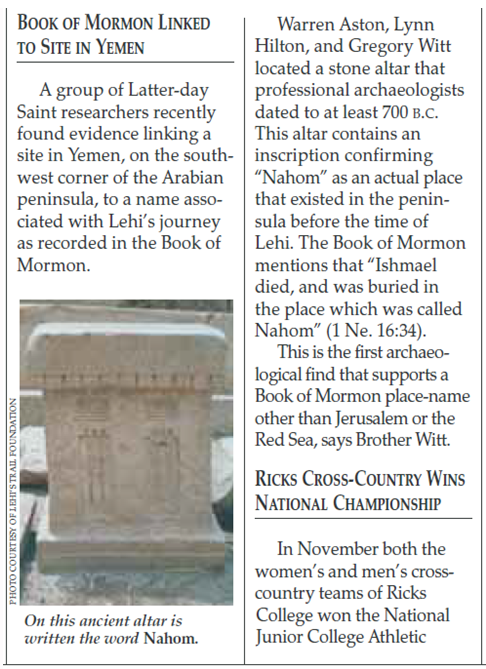
To illustrate the desperate measures the Church and its apologists will go to in pointing to anything as evidence for the historicity of the Book of Mormon, the Church actually tried to claim, in its graphic text, the following falsehood: "On this ancient altar is written the word Nahom." This is not true. The altar only has three consonants "NHM" inscribed on it. NHM does not equal "Nahom" and the fact that apologists like Peterson are trying to claim as such completely contradicts Peterson's "loosy-goosy parallelism" position.
Another noteworthy statement in the February 2001 Ensign article: "This is the first archaeological find that supports a Book of
Mormon place-name other than Jerusalem or the Red Sea".
John Hamer wrote:
Although some apologists have described the odds of this Nahom/Nihm/"NHM" correlation as "astronomical," it hardly even rises to the level of notable coincidence. The Book of Mormon derives its names from a book that has Semitic sources, i.e., the King James Bible. Many of the names in the Book of Mormon are just plucked directly from the Bible, e.g., "Lehi" (Judges 25:9), Laban (Gen. 24-30), Lemuel (Prov. 31:1-9). Other names, however, use the Bible as their inspiration with alterations, e.g., "Jarom" ("Joram" 2 Sam. 8:10), "Omni" ("Omri" 1 Kings 16:16), "Nehor" ("Nahor" Gen. 11:22). "Nahom" easily fits into the latter category: "Nahum" is actually a book in the Old Testament...
The evidences are insufficient to place Nahom with any certainty to any of the proposed locations. There just isn't much to work with here. We have:
To make this fit we have to make several assumptions:
In 2018, a man by the name of Andrew came in and single-handedly systemically destroyed the apologist's claims about their darling Nahom:
Another very relevant source about Nahom that debunks Nahom:
Joseph Smith Didn't Understand How Language Works and it Shows: Prt. 3 Nahom
When you have the Church and top Mormon apologists pointing to a "NHM" carving on an altar in Yemen from tiny group Lehites passing through to the Promised Land as their "favorite" and "actual archaeological evidence"? While being unable to point to any actual or "favorite" archaeological evidence to a massive steel-making horse-chariot riding Nephite/Lamanite civilization in the Americas that rivaled the Roman Empire? You know that it's bad.
Alright, as soon as I saw this, I recognized it. It's a map from a book done several years ago by Vernal Holley.
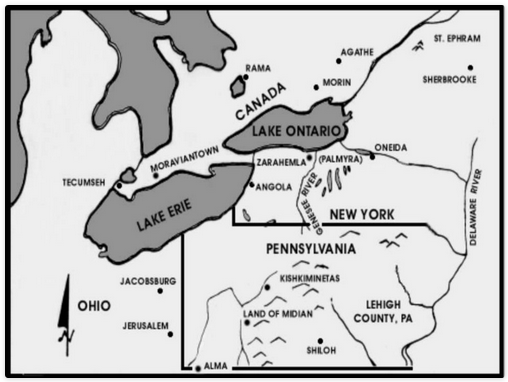
This is his fourth objection: Book of Mormon Geography, and he uses Vernal Holley, who relied on the Solomon Spalding theory of the Book of Mormon, which has been exploded, detonated so many times that its exasperating to see it keep coming back. I've mentioned, I think, here before that Hamblin and I have wanted to do a film that we call tentatively, "Bill and Dan's Excellent Adventure in Anti-Mormon Zombie Hell." The idea is that these just keep coming back. I mean, you shoot them between the eyes and they don't stop because there's no brain in there, right? And, I see the Spalding manuscript theory just keep coming and coming, but the methodological problems with Vernal Holley's maps are multitudinous and we published an article in the old FARMS Review clear back at the very beginning in 1989 showing some of those problems. For one thing, he goes to a map of the northeastern United States. He goes through all the toponyms, the place names there, and then he tries to find things in the Book of Mormon that are vaguely familiar. They sound sort of the same, but some of them are really a stretch. Jacobsburg, well that's Book of Mormon Jacobugath . Antioch, that's Anti-Anti. My favorite, Sherebrook, which becomes the Book of Mormon Shurr. Well, they're not very good parallels, but, the other thing is, they're in the wrong places. The Book of Mormon says where they are. They're not in the same relationships on the map. It's just...you know, if you take a long enough list of place names, you'll find parallels, especially if you're "loosy-goosy" about it. You'll find parallels with just about anything. This is easily done. I could show you words that definitely come from Arabic that occur in English, that have no relationship. They're vaguely similar. They're totally different definitions. If you have no standards for what counts as evidence, anything could count as evidence. Well, anyway, I don't want to go on at length about that. There's an excellent FairMormon response, a summation response, to Vernal Holley's maps. Again, no notice of it.
Peterson says: "They sound sort of the same, but some of them are really a stretch"
Peterson says: "It's just...you know, if you take a long enough list of place names, you'll find parallels, especially if you're "loosy-goosy" about it. You'll find parallels with just about anything. This is easily done. I could show you words that definitely come from Arabic that occur in English, that have no relationship. They're vaguely similar."
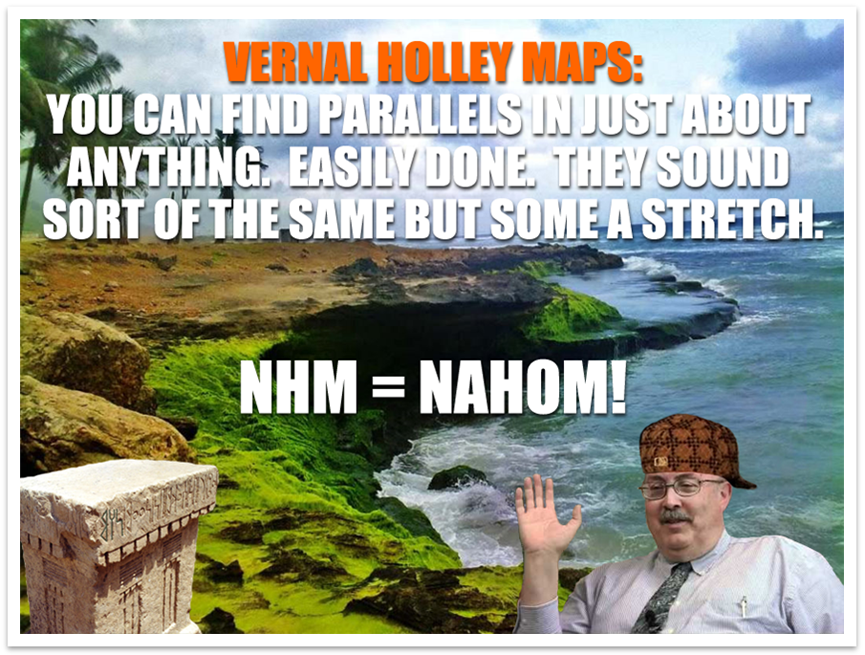
The Church, in its recent astounding Translation and Historicity of the Book of Abraham essay, doesn't have a problem with "loosy-goosy" parallelisms:
Olishem = Ulisum
Elkenah = "El" of Canaanite
Ritual Sacrifice = Capital Punishment
In Peterson's universe, when the Church and Mormon apologists do this? It's faith-promoting evidence. When critics do this? It's "loosy-goosy" parallelism.
Peterson says: "He goes through all the toponyms, the place names there, and then he tries to find things in the Book of Mormon that are vaguely familiar. They sound sort of the same, but some of them are really a stretch. Jacobsburg, well that's Book of Mormon Jacobugath . Antioch, that's Anti-Anti. My favorite, Sherebrook, which becomes the Book of Mormon Shurr. Well, they're not very good parallels, but, the other thing is, they're in the wrong places. The Book of Mormon says where they are. They're not in the same relationships on the map."
Peterson fails to mention the counterarguments to his "some names are in the wrong places on the map!" claim. My direct response to FairMormon's "wrong spots!" claims can be read here.
The Hill Cumorah isn't even in the right spot on the map, according to the "Limited Geography Model" espoused by both Peterson and his buddies. Never mind that Joseph Smith and "prophets, seers, and revelators" have taught it's in New York. Never mind that Joseph Smith was, in turn, taught about the Book of Mormon civilizations by an angelic Moroni who himself deposited the plates in Hill Cumorah. Never mind that the Church still holds Hill Cumorah pageants there today.
Unofficial apologists have to invent another Cumorah to try to make the dots line up. Yet, the dots aren't lining up. As long as this is the standard required, then having Ramah show up in the wrong place by a couple hundred miles isn't a big deal.
Complaining that Ramah and Morianton are in the "wrong place" on a map is an argument given by minds that believe the Book of Mormon names are real places. On the flip side of this same coin, a critic might say "Joseph & Co. made a mistake and didn't watch the geography carefully."
Here's the point that unofficial apologists and the "Joseph made a mistake and didn't watch his geography" critics fail to grasp: the point of the map is not whether or not it matches exactly. The point is that it matches mostly. There are a striking number of names around the location in which Joseph Smith grew up, similar versions of which are in the Book of Mormon. Moreover, many of these similar place names are also situated in a geographically similar manner to which they are situated in the Book of Mormon. The coincidence is simply too great to ignore.
The maps do not have to match perfectly or even have to make sense. It's like pointing out that Lord of the Rings' Minas Tirith didn't have enough farmland to support itself. Yes, Minas Tirith is a made up location. Getting it wrong in a fictional book is an indication it is fiction. Ramah being in Canada and being the name "Cumorah" in Jaradite just might be an indication that Joseph & Co. made stuff up.
Lord of the Rings J. R. R. Tolkien based his Middle Earth on locations around him at the time of his writings but he changed names and the map so that it would be "his own world." An exact match is not necessary.
We see this modus operandi of plagiarism from Joseph Smith in the Book of Abraham where he copied completely independent and unrelated hieroglyphics from one different papyrus to fill in the damaged section of Facsimile 2. He then gives completely inaccurate translations that he presumably pulled from his imagination. Even FairMormon concedes that Joseph copied the hieroglyphics.
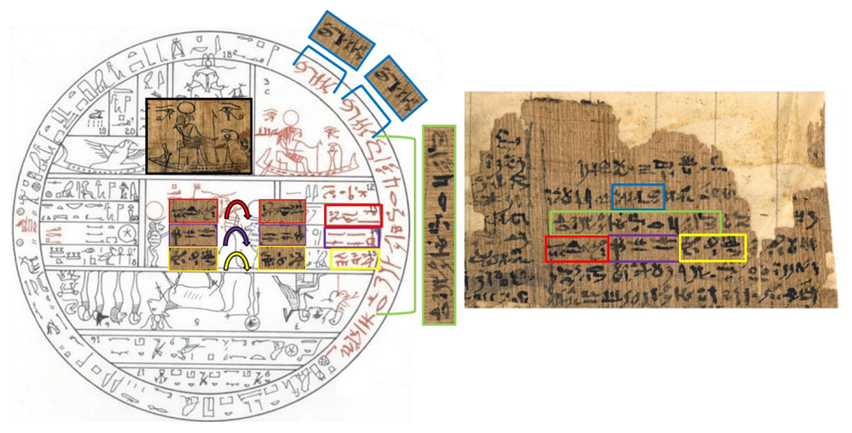
Credit: The Book of Abraham: Criticisms, Defenses, and Implications
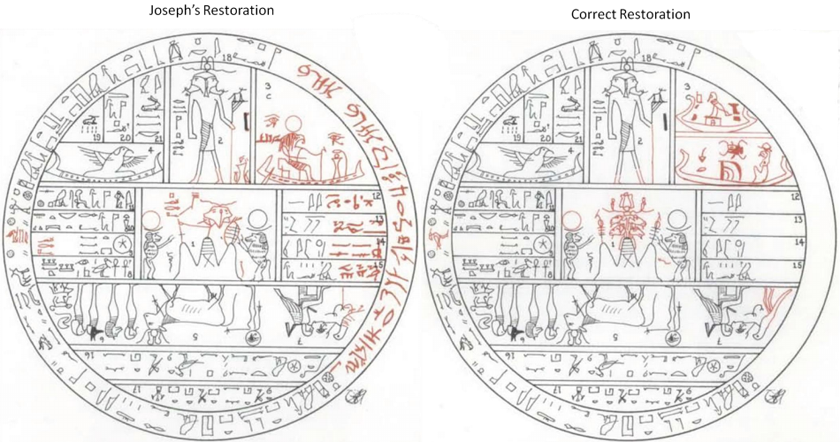
Credit: The Book of Abraham: Criticisms, Defenses, and Implications
Further, Joseph not only copied the above hieroglyphics into Facsimile 2, but he copied the following boat picture from the un-translated Book of Joseph papyrus to fill in the damaged section on the top right part of Facsimile 2:
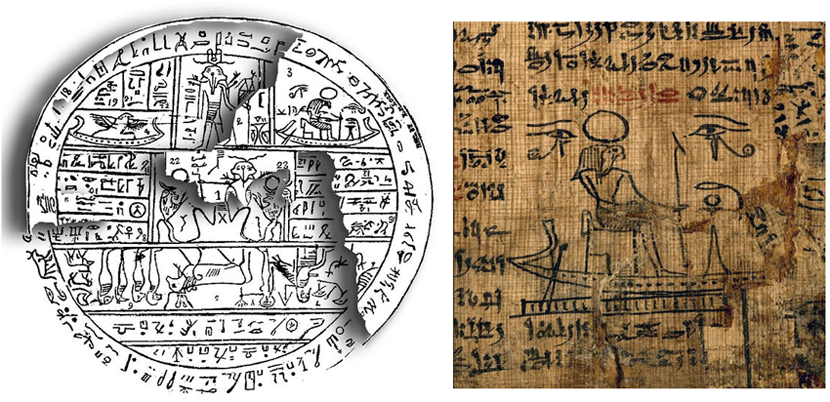
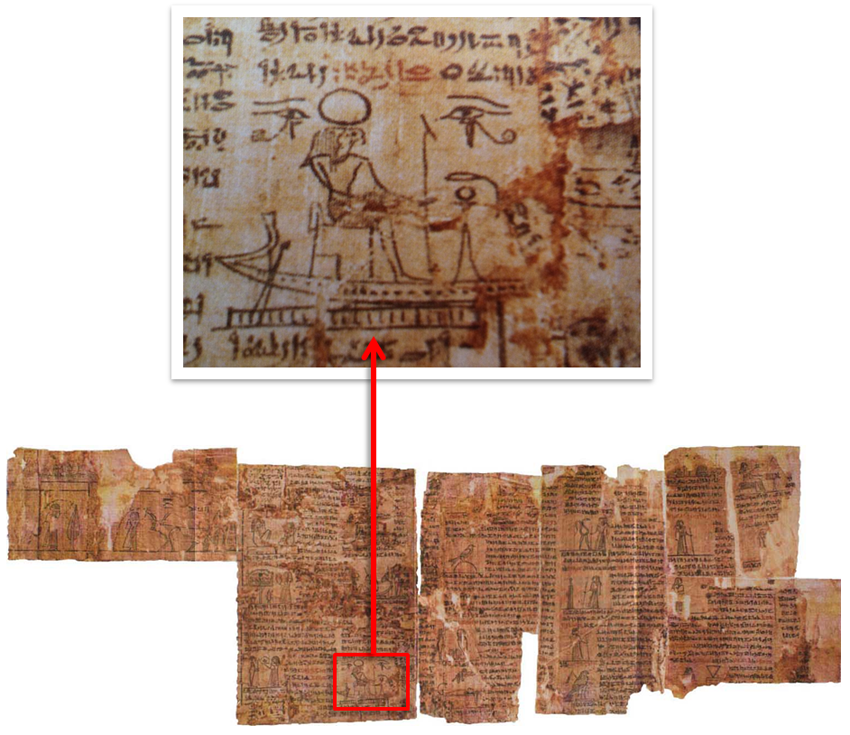
There is more evidence of the Book of Mormon setting being in Joseph Smith's region than there is for Peterson's and FairMormon's fringe Limited Geography Model.
The following links are some examples of hypothetical Book of Mormon geography maps illustrated by apologists:
As shown by these examples, Limited Geography apologists cannot even agree on where the events of the Book of Mormon took place. They have no real geographical setting in which to set the Book of Mormon. Not only do they have to ignore the astounding and uncanny similarities in town names in Joseph's backyard but they have to ignore Joseph Smith and other "prophets, seers, and revelators" who taught that the Book of Mormon took place in New York, Illinois, and elsewhere on the North American continent. Joseph even pointed to the Hill Cumorah as the actual Hill Cumorah in the Book of Mormon. This is not good enough, however, for Limited Geography apologists who insist they know better than Joseph Smith, latter-day "prophets, seers, and revelators" and the Church itself.
Peterson says: "There's an excellent FairMormon response, a summation response, to Vernal Holley's maps. Again, no notice of it."
Peterson continues to demonstrate his lack of understanding of the CES Letter and more importantly Debunking FairMormon.
Not only has there been notice of FairMormon's response to the Vernal Holley maps but I directly responded to FairMormon's response in my Debunking FairMormon here. It is unfortunate that I keep having to remind everyone about Peterson's Debunking FairMormon censorship.
Alright, I'm just going to go ahead and screenshot dump my direct response to FairMormon's Book of Mormon Geography and Vernal Holley Maps response so that my dear readers can see for themselves just how ridiculously false Peterson's "no notice of it" claim is:

Item number five. He refers to View of the Hebrews. Ethan Smith's, View of the Hebrews, which some critics see as a source for the Book of Mormon. We were so terrified of the View of the Hebrews at BYU that BYU actually published View of the Hebrews so people could see it. I mean, it's just not similar at all. But there's no engagement with that, no engagement with Larry Morris's superb year 2000 BYU Studies article on "Oliver Cowdery's Vermont years and the Origins of Mormonism" that shows that the link that people posit between Ethan Smith and Oliver Cowdery almost certainly didn't exist.
Peterson says: View of the Hebrews is "just not similar at all".
FairMormon says: "Some parallels do exist between the two books...this has obvious similarities to the story of the Nephites and the Lamanites in the Book of Mormon."
- Source
So, which is it? We can't even get Peterson and FairMormon to agree.
This is one example of what I mean when I say that Mormon apologists cannot even agree on the answers. I saw not just the poor quality in their answers but consistent contradictions among them as well. Again, this is what propelled my motivation to seek official answers from the CES Director.
LDS scholar and General Authority Elder B.H. Roberts - who actually devoted a considerable amount of time in researching View of the Hebrews and its parallels to the Book of Mormon - very strongly disagrees with Daniel Peterson's position and claim. Elder Roberts wrote:
Did Ethan Smith's View of the Hebrews furnish structural material for Joseph Smith's Book of Mormon? It has been pointed out in these pages that there are many things in the former book that might well have suggested many major things in the other. Not a few things merely, one or two, or half dozen, but many; and it is this fact of many things of similarity and the cumulative force of them that makes them so serious a menace to Joseph's story of the Book of Mormon origins." - Elder B.H. Roberts, Studies of the Book of Mormon, p.240
The following is a list of 34 parallels that I included in the CES Letter:

Not only does Peterson completely ignore these 34 parallels between the two books but he has the audacity to claim that it's "just not similar at all."
Peterson says: "But there's no engagement with that, no engagement with Larry Morris's superb year 2000 BYU Studies article on "Oliver Cowdery's Vermont years and the Origins of Mormonism" that shows that the link that people posit between Ethan Smith and Oliver Cowdery almost certainly didn't exist."
Again, Peterson demonstrates his lack of understanding that the CES Letter was a just list of concerns and questions for the CES Director to respond to and not a treatise or thesis on the theories, opinions and speculations of unofficial Mormon apologists.
Peterson recommends an article that, like his other recommendations, require us handing over our credit card to BYU Studies or Deseret Book. I went ahead and paid for access to the PDF article and read through it. The article does not provide any proof or convincing arguments that there was zero connection between Oliver Cowdery and his family's Church pastor, Ethan Smith. In fact, the author of the article, Larry Morris, admits:
"All of this does not prove that the Cowderys did not know Ethan Smith or that Oliver Cowdery was not aware of View of the Hebrews. What it does suggest, however, is that the theory of an Ethan Smith - Cowdery association is not supported by the documents and that it is unknown whether Oliver knew of or read View of the Hebrews." - p.120
Of course, Peterson won't let this stop him from making his unsubstantiated and unsupported claim that the link between Ethan Smith and Oliver Cowdery "almost certainly didn't exist."
Here is exactly what I wrote on this topic in the CES Letter:
Reverend Ethan Smith was the author of View of the Hebrews. Ethan Smith was a pastor in Poultney, Vermont when he wrote and published the book. Oliver Cowdery - also a Poultney, Vermont resident - was a member of Ethan's congregation during this time and before he went to New York to join his cousin (third cousins) Joseph Smith. As you know, Oliver Cowdery played an instrumental role in bringing forth the Book of Mormon.
LDS General Authority and scholar Elder B.H. Roberts privately researched the link between the Book of Mormon, the View of the Hebrews, Joseph's father having the same dream in 1811 as Lehi's dream, etc. that were available to Joseph Smith, Oliver Cowdery, Martin Harris and others before the publication of the Book of Mormon. Elder Roberts' private research was meant only for the eyes of the First Presidency and the Quorum of the Twelve and was never intended to be available to the public. Roberts' work was later published in 1985 as Studies of the Book of Mormon. At the conclusion of his research, Elder B.H. Roberts came to the following conclusion:
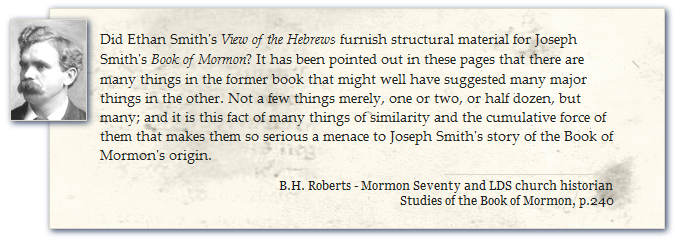
The fact remains that Ethan Smith was the pastor of the Congregational Church that Oliver Cowdery and his family attended and were members of during their time in Poultney, Vermont. Daniel Peterson and his buddies want you to believe that this is purely coincidental and that there is absolutely no connection between Oliver and his pastor or his View of the Hebrews book.
Fawn Brodie wrote regarding the idea of coincidence: "it may never be proved that Joseph saw View of the Hebrews before writing the Book of Mormon, but the striking parallelisms between the two books hardly leave a case for mere coincidence."
LDS scholar and General Authority Elder B.H. Roberts agreed and believed the evidence was very persuasive and strong that there was not only an Ethan Smith-Oliver Cowdery connection but a View of the Hebrews-Book of Mormon connection as well.
He then gets into, in item number six, The Late War, which has already been here. It's a retelling of the War of 1812 in biblical style. No mention of Ben McGuire's article in Interpreter Volume 7 from last year. Even in his revised version of his letter, I don't think that there's one - I may have missed it. I have to admit I had a hard time concentrating on the letter, but I didn't see one. And now he's going to have to deal with the presentation yesterday by Matt Roper and Paul Fields. There are just all sorts of problems.
This is a great example of Mormon apologists not only not directly answering the questions and problems but also pointing to sources that also likewise do not answer the questions and problems.
Peterson points to his own organization's (Interpreter) paper as a source for answers to Late War's amazing parallels to the Book of Mormon. Here is the money quote in this article's very first paragraph:
"I will discuss only the statistical model presented by the Johnsons here."
It's not even addressing the questions and problems! Nothing about the numerous parallels between Late War and the Book of Mormon. Nothing about the numerous themes between Late War and the Book of Mormon.
We're off to a bad start here, Dan.
Hopefully Peterson's next recommendation will do the trick. Peterson then recommends FairMormon's presentation given by Matt Roper and Paul Fields. I went to FairMormon's Conference page in hopes of accessing this source only to find that it's inaccessible:

Since both of Peterson's sources are either irrelevant or inaccessible, I'll just take the floor to provide information that actually is relevant and accessible:
The Late War Between the United States and Great Britain: This was an 1819 textbook written in King James Version style language for New York state school children, one of them very likely being Joseph Smith. The first chapter alone is stunning as it reads incredibly like the Book of Mormon:
Along with the above KJV language style presence throughout the book, what are the following Book of Mormon phrases, verbatim, themes, and storylines doing in a children's school textbook that was used in Joseph Smith's own time and backyard? A mere decade before the publication of the Book of Mormon?
The staggering parallels and similarities to the Book of Mormon are astounding. This outstanding web page outlines very clearly and simply just how devastating the Late War is to the Book of Mormon and its claims.
Rick Grunder states in his paper:
"The presence of Hebraisms and other striking parallels in a popular children's textbook (Late War), on the other hand - so close to Joseph Smith in his youth - must sober our perspective." - p.770
I cannot overemphasis just how powerful and amazing this webpage is and how you must visit it to appreciate the astounding parallels and themes between the Late War and the Book of Mormon. Visit the webpage here.
Peterson again attacks the CES Letter with a blanket "there are all sorts of problems" without actually outlining exactly what those "problems" are. A common tactic that Mormon apologists such as Peterson employ are blanket hit-and-runs where they shout, "There's too many problems!" while not providing specifics to support their claims and assertions.
Another tactic Mormon apologists use is to claim that such-and-such issue or problem is "old" and "unoriginal" and which has already been "thoroughly answered and debunked" while pointing to sources that do not even answer or address the problem. Peterson's pointing to his own organization's (Interpreter) paper on the Late War is an example of this as the paper doesn't even address the parallels and themes common between the two books, a main point in the CES Letter.
The Late War completely demolishes the decades old Mormon apologetic claim that "Hebraisms" are evidences to the Book of Mormon's antiquity and authenticity.
Let's go on a little bit further. Here's an illustration: A traditional view of Joseph Smith translating the Book of Mormon.

Now, there are several things wrong with it, and he points to this sort of thing and says this is Church deception. Joseph didn't have the plates with him quite often, and here he is, following along with the text on the plates. Well, you know that's not true, because the witnesses didn't see the plates all the time, right? This can't possibly be true. When the witnesses saw the plates it was a big deal for them, because Joseph wasn't just sitting there translating with the plates in front of him all the time as people wandered around and so on. But he says, "Look, the Church is being deceptive", because it doesn't show Joseph with his face in the hat using the seer stones. Well, my response to this partly would be, "What in the world are you thinking of?" Trying to derive doctrine from illustrations? Or expecting that illustrations are going to give you the accurate picture?
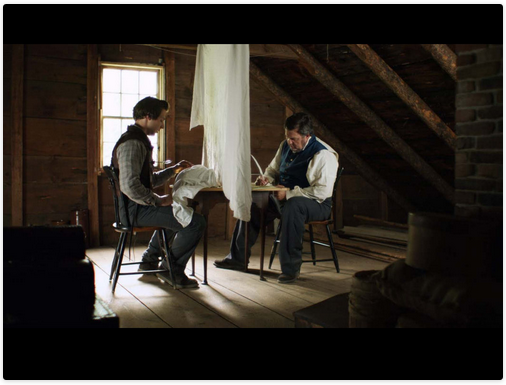
Here's another one: There Joseph has the curtain between him and the scribe. That's also wrong. I'll come back to that.
Peterson's "Joseph didn't have the plates with him quite often" claim is disingenuous. There is no "quite often". The Book of Mormon that we have today? No gold plates were used. The gold plates were not used after Martin Harris lost the 116 pages. Joseph then solely used his treasure hunting method of looking at a rock in his hat - a common rock that he found in his neighbor's well - that he placed in his hat to tell his customers where gold and silver was buried. Joseph was taken to court on charges of fraud related to his treasure hunting activities.
This is the method of fraud in which the "keystone" of Mormonism was conceived and birthed in.
It is disingenuous of Peterson to not showcase the unbelievable discrepancy between the fictional "gold plates" translation and Joseph's "rock in hat" translation, the latter method which Peterson gives a passing glance at.
As I stated in the CES Letter regarding the gold plates:
At the end of the day? It all doesn't matter. The Book of Mormon Witnesses and their testimonies of the gold plates are irrelevant. It does not matter whether eleven 19th century treasure diggers with magical worldviews saw some gold plates or not. It doesn't matter because of this one simple fact:
Joseph did not use the gold plates for translating the Book of Mormon.
While Peterson is distracting his audience with curtains and gold plates (which, again, weren't even used for the Book of Mormon we have today), he fails to clearly convey and illustrate the stark contrast between how the Church presents the Book of Mormon translation versus what the historical record shows happened:
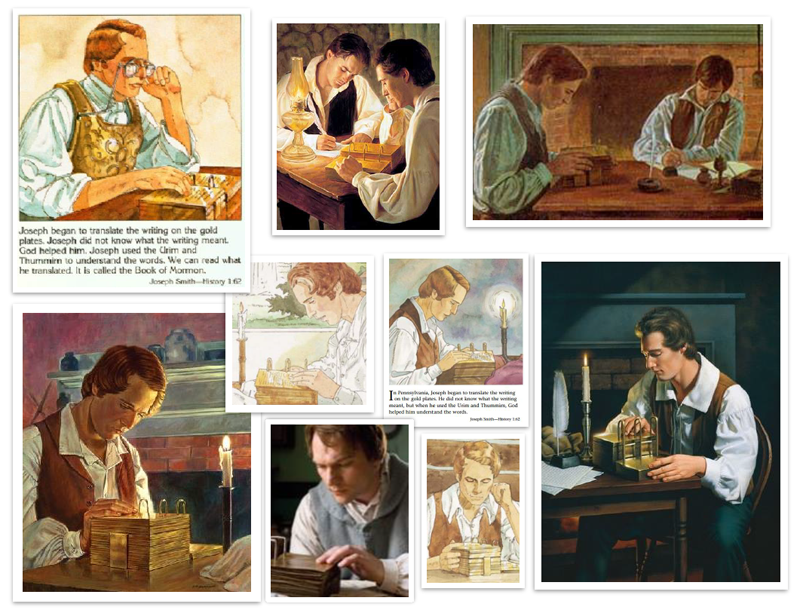

LDS scholar and historian Richard Lyman Bushman gets it:
I will begin by saying that we still have pictures on our Ward bulletin boards of Joseph Smith with the Gold Plates in front of him. That has become an irksome point and I think it is something the church should pay attention to. Because anyone who studies the history knows that is not what happened. There is no church historian who says that is what happened and yet it is being propagated by the church and it feeds into the notion that the church is trying to cover up embarrassing episodes and is sort of prettifying its own history.
So I think we should just stop that immediately. I am not sure we need a lot of pictures of Joseph looking into his hat, but we certainly should tell our children that is how it worked. It's weird. It's a weird picture. It implies it's like darkening a room when we show slides. It implies that there is an image appearing in that stone and the light would make it more difficult to see that image. So, that implies a translation that's a reading and so gives a little clue about the whole translation process. It also raises the strange question, what in the world are the plates for? Why do we need them on the table if they are just wrapped up into a cloth while he looks into a seer stone?
- Richard Bushman, LDS Scholar, FAIR Podcast, Episode 3: Richard L. Bushman p.1, 47:25
Peterson attempts to justify and diminish the decades of fraud and deception through art perpetuated by the Church still today by pointing out, as he does in the following examples, that other art do not reflect reality as well.
Peterson also attempts to justify and diminish the fraud by continuing his "blame the victim" attacks in his shifting the blame and responsibility from the Church over to the members and investigators for trusting that the Church was conveying accurate history through its art:
Well, my response to this partly would be, "What in the world are you thinking of?" Trying to derive doctrine from illustrations? Or expecting that illustrations are going to give you the accurate picture?
It's not just the art. It's the movies that kids are seeing in Church and seminary as well as missionaries showing investigators. The LDS backed film Joseph Smith: The Prophet of the Restoration is a glaring example of this as it portrays the plates in the translation process as Joseph scrolls his finger on the plates (see clip below). No rock in the hat in sight. Not only are these folks being shown a complete myth (no gold plates were used and no rock in hat shown) but they're not even given the chance of learning the strange rock in the hat version because the Church isn't giving it to them. The rock in the hat translation method is extremely valuable information to have in determining whether or not you want to devote your life and 10% of your paychecks to Mormonism.
The Book of Mormon translation art and movies specifically depict something completely contrary to what is known and accepted by all LDS and non-LDS historians and scholars to be true. The Church has known for decades that no gold plates were used for the Book of Mormon we have today and that Joseph used a rock in a hat instead. And the Church has perpetuated this lie - for decades - to generations of Mormons. The Church continues this deception and dishonesty still today. This isn't artist interpretation. This is deliberate and systematic fraud on the part of the LDS Church as the Church knows the art is dishonest and deceptive but it continues to commission the deceptive art in its buildings and materials anyway.
It is high time the Church not only corrects the art to match the actual historical record but become transparent to the members in that Joseph used a rock in a hat for the Book of Mormon translation. LDS scholar Richard Bushman concurs.
This one is equally wrong. It's not a sign of evil or deliberate conspiratorial intent. It's just an indication that the illustrators often just don't get it right. And I'll give you some other illustrations of that sort of thing. Look at this famous picture.

All right? Now that's Samuel the Lamanite on a Nephite wall. Are any walls like that described in the Book of Mormon? No. You have these simple things, and they're considered quite a technical innovation at the time of Moroni, where he digs a trench, piles the mud up, puts a palisade of logs along the top. That's it. They're pretty low tech. There's nothing like this. This is Cuzco or something. But this is hundreds of years after the Book of Mormon and probably nowhere near the Book of Mormon area and, you know, and you've heard me say it before, after Samuel jumps off this Nephite wall you never hear about him again. The obvious reason is...he's dead. He couldn't survive that jump. But again, do you draw your understanding of the Book of Mormon from that image? Or, do you draw it from what the book actually says?
There is a key distinct difference between "high tech" vs. "low tech" walls and gold plates vs. rock in a hat Book of Mormon translation.
There is a key distinct difference between Samuel the Lamanite on a wall versus Joseph "translating" the keystone Book of Mormon using the same exact method he used to con his customers out of their money - and being taken to court for fraud - during his treasure hunting days just a few years prior to "translating" the Book of Mormon.
For Peterson to attempt to obfuscate and even compare the two in his bid to defend and rationalize the Church's decades-long blatant deception and dishonesty is in itself dishonest.
Peterson fails to address how members and investigators are supposed to know the art is not only incorrect but deceptive when the Church itself is putting this deceptive art in its own Sunday School, Priesthood, Relief Society and Young Men/Women manuals as well as in the pamphlets and other materials used by missionaries to convert investigators. Peterson makes it sound like members are privately distributing the art when the reality is that the Church is distributing the art in its system with its own logo emblazed on the back. When the reality is that the Church is hanging up these art in its own Temples, Conference Center, Visitor Centers, History Museum and meetinghouses.
In Peterson's universe, it's not the Church's fault for distributing and inserting incorrect and deceptive art into its educational materials for its members and investigators. It's the member's and investigator's fault for not figuring out on their own that their trust in the Church to be honest and transparent is misplaced.
The problem is not just the art. It's the omission of not telling the rest of the story to the members and investigators. The Church is not only misrepresenting what happened; the Church is not telling its Chapel Mormons and investigators what really happened.
Now, artists typically don't get things right, or quite often don't get things right. I'll tell you a quick story about this one. I hesitate to go on too long because I don't have much time. This is a very famous illustration of the eight witnesses.
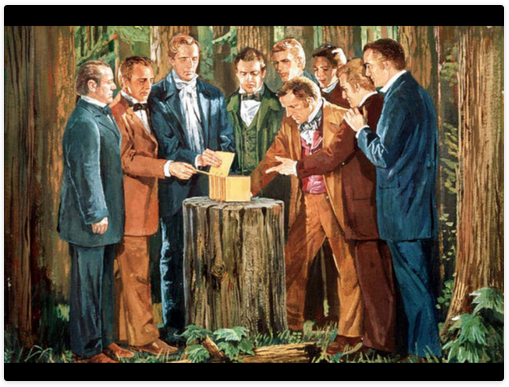
I had a discussion online years ago with an ex-Mormon critic. Some of you know the name, Brent Metcalfe. And we were arguing back and forth about the existence of the plates. And he said that all of the experiences of the witnesses were visionary. They just imagined things. They were hallucinating. And I said...but the Eight Witnesses were really, really...it's a matter of fact sort of experience: they go out in a clearing in the woods. There are the plates on a tree stump, they heft them and all this sort of thing, and he said "There was no tree stump." And we went back and forth and back and forth this stupid tree stump. And I finally said, "Look, OK. I will grant you no tree stump if you will grant me the plates...because I don't care about the tree stump." But in the meantime, I wrote a letter to my friend Richard Anderson, whose name will come up again in a minute, if I have a minute, who I think is one of the great historians in the Church, and he's the great authority on the witnesses. And I said, "Richard, help me. I cannot find a source indicating there's a tree stump." And he said, "Oh yeah, definitely there is, there is. I'll get it back to you." A few days later he calls and he says, "You know, I can't find any mention of a tree stump." And we both finally decided it was that stupid picture that gave us the idea. There's actually no account that mentioned a tree stump. So, pictures can form your image, but you have to be careful you're always controlling those images by looking at the actual data.
If PhD Dan Peterson, who makes a living teaching and defending Mormonism, gets confused about "facts" that come from Church artwork, what can we expect of the teenagers in seminary classes, missionaries in the field and investigators investigating being shown historically inaccurate art and videos of events of church history and the Book of Mormon translation?
Peterson attempts to defend deceptive and incorrect Church art by demonstrating how he himself was deceived by Church art.
Thanks for demonstrating my point, Dan.
As for Peterson's portrayal of "ex-Mormon critic" Brent Metcalfe? Mr. Metcalfe's response to Peterson's characterization of him and their conversation:
Dan Peterson is right that I corrected his misuse of the stump to establish physicality for the 8 witnesses' experience, but the language he attributes to me doesn't sound like me. "Hallucination" and cognates, for example, are not how I would describe the witnesses' experience. I searched through my folder that preserves thousands of files of online exchanges I've participated in and I could not locate a single instance where I've used "hallucination" or cognates in any context, though I found examples where Peterson has.
Mr. Metcalfe has had years of interactions with Daniel C. Peterson and other Mormon apologists and he was recently interviewed by John Dehlin with Mormon Stories where they had an extremely fascinating and captivating conversation. The last piece of his interview where Metcalfe focuses specifically on his experiences with Daniel C. Peterson and Mormon apologetics can be listened to here.
OK, now it's not just the Mormons who do this sort of thing. Have any of you read, "Out of the Silent Planet" by C.S. Lewis? C.S. Lewis is a passion of mine. This is a great novel, first of the so-called Perelandra trilogy.
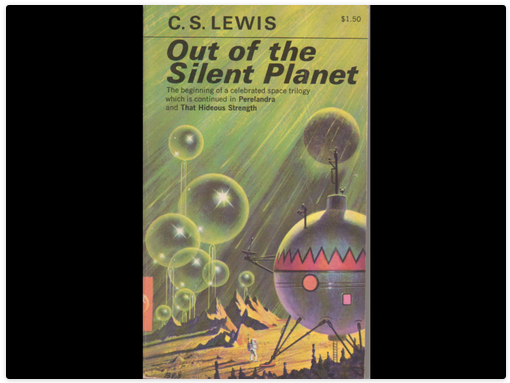
Now, if you've read the story, you know, that image, on the cover, that's the first cover of the novel when I bought it, that cover bears almost no relationship to the actual story. There's nobody in a space suit in that. This looks like the surface of the moon or something. The story describes Mars, which is where it takes place. Malacandra, it's called, in the novel, describing it very, very differently from that. So, this illustrator, I assume, hadn't even read the book.
But here's another one: Flight of the Holy Family into Egypt.
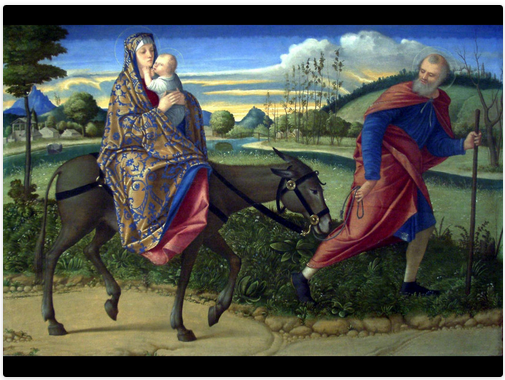
Now if you look at these pictures, and there are lots of them, it is a favorite topic for artists within a certain period. It's amazing how they think Egypt looked. The route, say, between Bethlehem and Egypt. It's like going through Flanders, and some, it's like you have to cross the Swiss Alps. I guarantee you, the Sinai looks nothing like this. Anyway, they're often dressed like Turks with turbans. Those things just totally inaccurate, totally inaccurate. Frankly, for that matter, some of you remember Ben Hur. Ben Hur is arrested in Jerusalem and he has to go to the galleys, right? Do you remember the scene? It's a wonderful scene, very moving, where he's going along...he's dying of thirst crossing sand dunes and so on, and he encounters the Savior, and the Savior gives him water to drink. My question, though, is, "If he's been arrested in Jerusalem and he's going to the sea, which is the Mediterranean, is he going via the Gobi Desert or something?" I mean, that's actually one of the most fertile areas of Israel. You're going along the plains of Sharon. Its agricultural land, and it's not very far. You wouldn't die of thirst even if you walked that hardly without a drink at all. So people always assume...they set up these images of what the place looks like, but they're wrong.
Like Peterson, FairMormon tried to pull the same stunt in their attempt to justify and rationalize the Church's dishonest artwork. I debunk this claim in detail here.
This absurdity reminds me of the Q&A session between FairMormon President Scott Gordon and Mormon Stories John Dehlin (see video below). Scott tried to defend the Church's art work and racism by pointing to other non-Mormon art work and churches that likewise got their art work wrong and discriminated against blacks at the same time. In other words, it's not so bad because others are doing it wrong too!
The LDS Church doesn't claim to be just another Church. It claims not only that it's unique but that it operates under "divine authority" and "continuing modern revelation". It doesn't matter that the Baptists were racist in 1955. They don't claim to have a living Prophet and 12 Apostles who speak directly to God.
It doesn't matter if the "artists got it wrong". The art was commissioned and approved many times spanning over a period of 40+ years over and over and over again. Prophets and Apostles have seen the art. They have approved the art in not only the Church's buildings and Temples but in its materials as well. Elder Nelson knew about the rock and the hat as far back as 1993. Elder Maxwell knew at least since 1988 when he published his Not My Will, But Thine. They both knew that the Book of Mormon translation art that the Church was officially publishing and putting up on walls was a fraud.
Further, some of the non-LDS religious art that FairMormon uses to demonstrate their point that religious art is often inaccurate and incorrect misses the other point: they're not being officially used by the "one true and only true Church" being led by God himself for official purposes to teach and convey a story and message to both members and investigators. It's fraud. It's a fraud because the Church knows it didn't happen this way but they continue to display still in 2014 these deceptive images for millions of their members and investigators to see and assume that this is how it happened.
Here's a clip of Church president Russell M. Nelson "demonstrating" the rock in the hat method:
Notice that President Nelson says "suggestions" when it's a fact that is now accepted by historians and scholars on both sides. Also notice how uncomfortable he is and how he folds and squeezes his hands together as he attempts to disclose a foreign translation process that would shock and surprise the average Chapel Mormon.
After placing the hat near his face, Nelson then awkwardly tries to make the weird seem normal or plausible by taking a page out of Dieter Uchtdorf's playbook in hilariously comparing this process to cell phones.
There's no explanation from Nelson on the discrepancy between what he's now saying versus how the Church indoctrinated generations of Latter-day Saints on the Book of Mormon translation. Also no explanation from Nelson about folk magic treasure digging and how Joseph and his family used the same method in conning people out of their money for buried treasure as he used for "translating" the Book of Mormon.
And just like that, kids, the keystone of our religion literally came out of a hat and we're now being sold the idea that rocks were 19th-century iPhones.
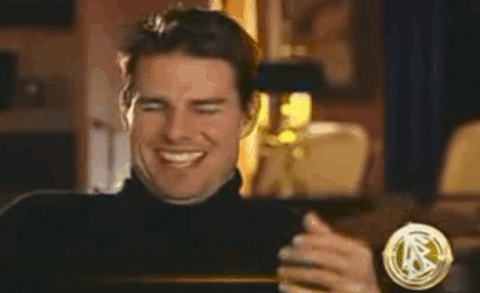
Here's a screenshot of the recent January 2021 Liahona in how the Book of Mormon was translated:

Source: January 2021 Liahona, page 29
Notice no rock in the hat. Just the same fictitious plates on a table translation process the Church deceived its members for generations. They are misleading members of the Church about the truth of the Book of Mormon translation process still in 2021.
So, yes, while the Church will occasionally release essays and videos that superficially go over some troubling historical issues (rock in the hat Book of Mormon translation, etc.), the reality is that when they are mass producing materials for members who aren't asking questions, such as the Liahona magazine, the Church continues to fall back on incorrect and long disproven images and sources.
This tells you everything you need to know about the Church's confidence that if they ever told members the real history, including how the Book of Mormon was really translated, on whether the members would continue to stay in the Church.
The Church has been and continues to be dishonest about how the Book of Mormon was really translated. LDS historian and scholar Richard Bushman agrees:
I will begin by saying that we still have pictures on our Ward bulletin boards of Joseph Smith with the Gold Plates in front of him. That has become an irksome point and I think it is something the church should pay attention to. Because anyone who studies the history knows that is not what happened. There is no church historian who says that is what happened and yet it is being propagated by the church and it feeds into the notion that the church is trying to cover up embarrassing episodes and is sort of prettifying its own history.
So I think we should just stop that immediately. I am not sure we need a lot of pictures of Joseph looking into his hat, but we certainly should tell our children that is how it worked. It’s weird. It’s a weird picture. It implies it’s like darkening a room when we show slides. It implies that there is an image appearing in that stone and the light would make it more difficult to see that image. So, that implies a translation that’s a reading and so gives a little clue about the whole translation process. It also raises the strange question, what in the world are the plates for? Why do we need them on the table if they are just wrapped up into a cloth while he looks into a seer stone?”
- Richard Bushman, LDS Scholar, FAIR Podcast, Episode 3: Richard L. Bushman p.1, 47:25
It's important to remember the big picture here. I can think of no better concise and succinct statement about the core issue of the rock and the hat Book of Mormon translation problem and the Church's decades of hiding and covering this up than this:
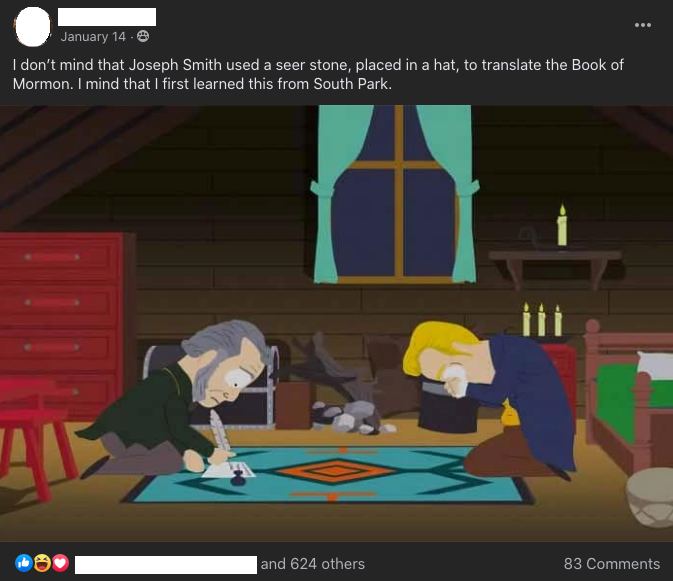
In November 2003, the best place to learn about how the Book of Mormon was really translated was not from the LDS Church but from South Park. Here's the relevant part from South Park's November 2003 "All About Mormons" episode (Season 7 - Episode 12):
Here's some comments from the same above Facebook post screenshot talking about this issue:

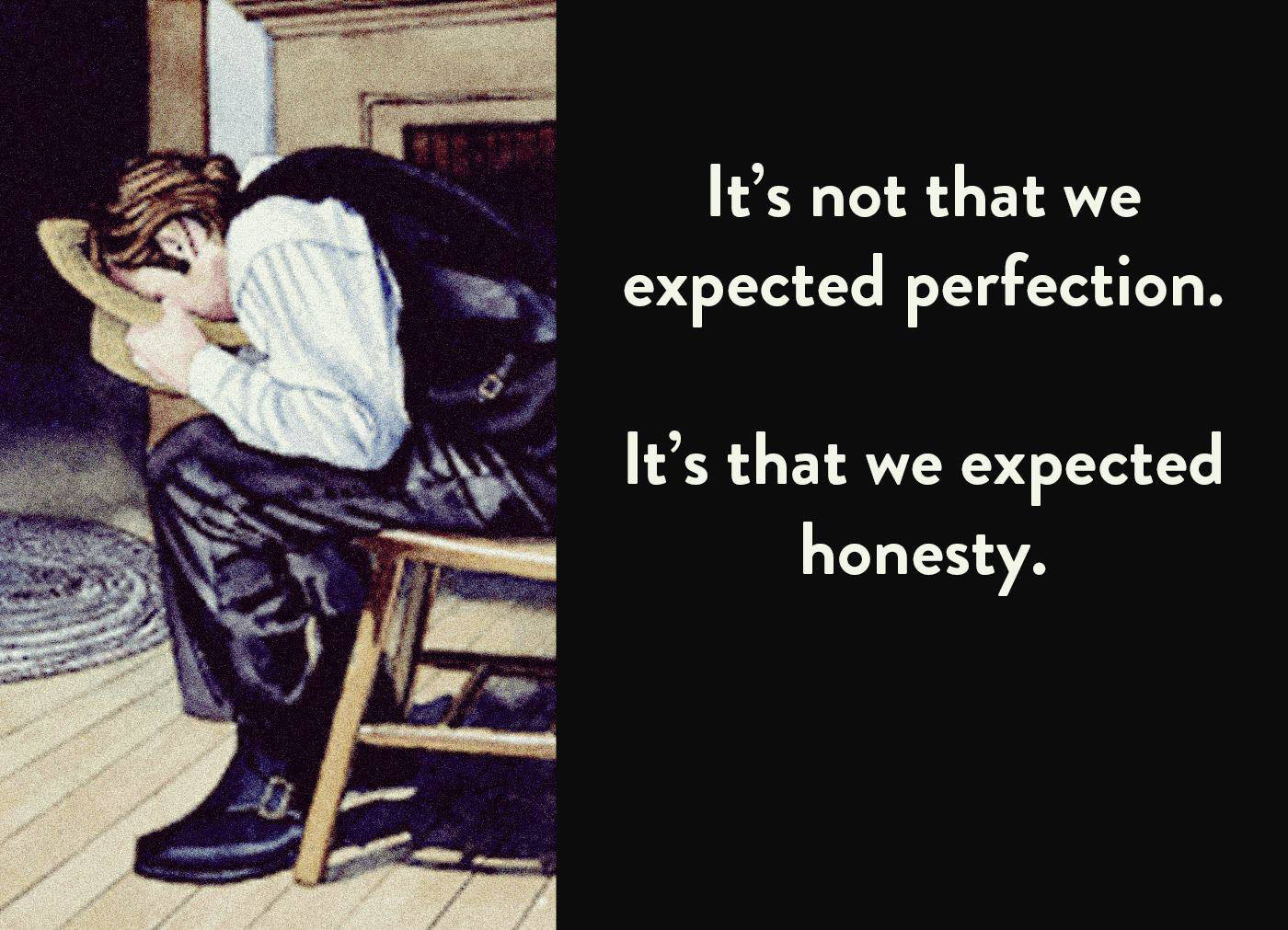
OK, now this is not the Flight of the Holy Family into Egypt. This is Royal Skousen, and I want to say something about some things that I derive from Professor Skousen's wonderful work on the textual history of the Book of Mormon, which are relevant to the question of Book of Mormon translation.
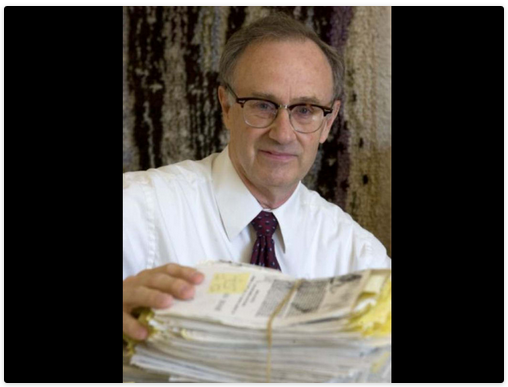
I'm going to read a little bit here. Professor Royal Skousen of Brigham Young University, an internationally respected linguistic theorist, has devoted more than a quarter of a century to intensive study of the text of the Book of Mormon, and most especially to the original and printer's manuscripts of the book. His work has appeared in large, handsomely produced volumes published by BYU's Maxwell Institute for Religious Scholarship, Yale University Press, and now, to our delight and honor, the Interpreter Foundation. It's professor Skousen's strongly considered opinion that the manuscript evidence supports the traditional account of the origin of the Book of Mormon, and that it does not support the notion that Joseph Smith composed the text himself, or took it from any other existing manuscript. Yet all the witnesses thought that Joseph Smith somehow saw words, and read them off to his scribes. Taken together, these two facts are highly significant. Now I want to briefly examine some of the relevant data. First of all, the evidence strongly supports the traditional account in saying that the original manuscript was orally dictated. The kinds of errors that occur in the manuscript are clearly those that occur from a scribe mishearing, rather than from visually misreading, while copying from another manuscript. The printer's manuscript, by contrast, shows precisely the types of anomalies that one would expect from a copyist's errors. Skousen's meticulous analysis even suggests that Joseph was working with up to about 30 words at a time.
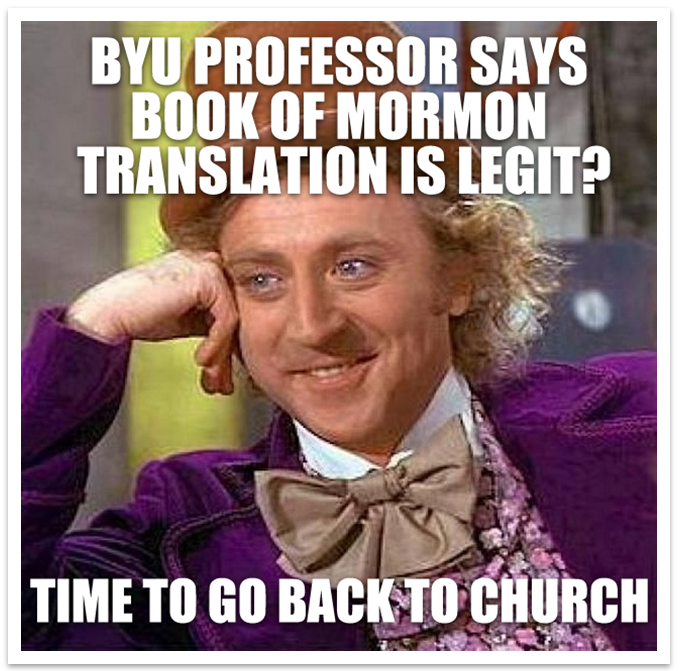
It's apparent too that Joseph could see the spelling of names on whatever it was that he was reading from. When the scribe had written the text, he or she would evidently read it back to Joseph for correction. So, the Prophet seemingly had something with him from which he was dictating, and against which he could check what his scribes had written. But what was it? The witnesses are unanimous that he didn't have any books, manuscripts or papers with him during the translation process, a process that involved lengthy periods of dictation. For example, in an interview with her son, Joseph Smith III, not long before she died, Emma Smith insisted that Joseph had no text with him during the time of translation.
Question: Had he not a book or manuscript from which he read or dictated to you?
Answer: He had neither manuscript nor book to read from.
Question: Could he not have had, and you not know it?
Answer: If he had had anything of the kind, he could not have concealed it from me.
"In writing for your father," she told her son, "I frequently wrote day after day sitting at the table close by him, he sitting with his face buried in his hat with the stone in it dictating hour after hour with nothing between us." Note: Nothing between us, no curtain. "The plates often lay on the table without any attempt at concealment, wrapped in a small linen tablecloth which I had given to him to fold them in. I once felt of the plates as they lay thus on the table, tracing their outline and shape. They seemed to be pliable like thick paper, and would rustle with a metallic sound when edges were moved by the thumb, as one does sometimes thumb the edges of a book."
Now, Emma Smith could speak authoritatively regarding the period during which she herself served as scribe, but what about the much longer period when it was Oliver Cowdery who was taking the dictation? In fact, Emma could speak from personal experience with respect to that time as well. While they were in Harmony, Pennsylvania, where most of the Book of Mormon text was committed to writing, Emma says that Joseph and Oliver were not far away from her.
"Question: Where did father and Oliver Cowdery write?"
"Answer: Oliver Cowdery and you father wrote in the room where I was at work."
Not long after speaking with her, Joseph III wrote a letter in which he summarized some of her responses to his questions. "She wrote for Joseph Smith during the work of translation, as did Reuben Hale, her brother, and O. Cowdery, that the larger part of this labor was done in her presence and where she could see and know what was being done, that during no part of it did Joseph Smith have any manuscript or book of any kind from which to dictate, except the metallic plates, which he knew he had. Nor, incidentally, did Emma believe that Joseph Smith was capable of inventing the Book of Mormon and dictating it off the top of his head. "Joseph Smith," she said, "could neither write nor dictate a coherent and well-worded letter," her son's note reported as telling him, "let alone dictating a book like the Book of Mormon."
A correspondent from the Chicago Times interviewed David Whitmer on the 14th of October 1881, and got essentially the same account. "Mister Whitmer emphatically asserts, as did Harris and Cowdery, that while Smith was dictating the translation, he had no manuscript notes, or other means of knowledge, save the seer stone and the characters as shown on the plates, he being present and cognizant how it was done." Similarly, the Saint Louis Republican, based upon an interview in mid-July of 1884, reported that "Father Whitmer, who was present very frequently during the writing of the manuscript of the Book of Mormon, affirms that Joseph Smith had no book or manuscript before him from which he could have read, as asserted by some that he did. He, Whitmer, having every opportunity to know whether Smith had Solomon Spalding's or any other person's romance to read from."
David Whitmer repeatedly insisted that the translation process occurred in full view of Joseph Smith's family and his associates. It would appear, in fact, that the common image of a curtain hanging between the Prophet and his scribes, sometimes seen in illustrations as we saw here, of the story of the Book of Mormon, was not the usual modus operandi. There was indeed a curtain, at least in the latter stages of translation process, however that curtain was suspended not between the translator and his scribe, but near the front door of the Peter Whitmer home in order to prevent idle passers-by and gawkers from interfering with the work. In order to give privacy to the proceeding, a blanket..." Well, I don't think I need to quote this, it makes the point.
On another occasion Whitmer recalled, "I often sat by and heard them translate and write for hours together. Joseph never had a curtain drawn between him and his scribe while he was translating. He would place the director in his hat and then place his face in his hat so as to exclude the light, and then read the words as they appeared before him."
And there's more evidence that Joseph was not simply reading from a manuscript. Here's a quotation from David Whitmer again. "He could not translate unless he was humble and possessed the right feelings towards everyone. To illustrate, so you can see, one morning when he was getting ready to continue the translation, something went wrong about the house and he was put out about it, something that Emma, his wife, had done. Oliver and I went upstairs, and Joseph came up soon after to continue the translation, but he couldn't do anything. He could not translate a single syllable. He went downstairs out into the orchard and made supplication to the Lord," something he liked to do. He liked to pray in groves of trees. He does it again here. It's a characteristic. "He made some supplication, was gone about an hour, came back to the house, asked Emma's forgiveness and then came upstairs where we were and the translation went on alright. He could do nothing save he was humble and faithful."
And there are other accounts where Whitmer tells the same story to newspapers. It would seem from this anecdote that Joseph needed to be in some way spiritually or emotionally ready for the translation process to proceed, something that would be wholly unnecessary if he had simply been reading from a prepared manuscript. As David Whitmer explained, Joseph occasionally "found he was spiritually blind and then could not translate. He told us that his mind dwelt too much on earthly things, and various causes could make him incapable of proceeding." Now at this point a skeptic might, of course, suggest, that emotional distractions interfered with Joseph Smith's ability to remember a text he had memorized right the night before for dictation to his naive secretaries, or that personal upheavals hindered his improvising of an original text for them to write down as it occurred to him. But such potential counter-explanations run into their own serious difficulties. I just want to ask, do you even think it's remotely possible? I don't. To imagine Joseph Smith, or anyone else, memorizing or composing nearly 5000 words daily, day after day, week after week, in the production of a lengthy and complex book. That's a question you can ponder for yourselves. I'll simply say that, as someone who writes a lot, and rapidly, and has kept a daily record of how many words I produce each day for many of the past 15 years, I've never come close to maintaining a pace like this, even on a computer. I just find it impossible to imagine.
I break up and respond to the above claims below.
Peterson says: "The witnesses are unanimous that he didn't have any books, manuscripts or papers with him during the translation process, a process that involved lengthy periods of dictation. For example, in an interview with her son, Joseph Smith III, not long before she died, Emma Smith insisted that Joseph had no text with him during the time of translation."
The facts that there are exact and obscure 1769 KJV edition errors and 17th century KJV italics present in the Book of Mormon completely contradicts and obliterates the "he didn't have any books, manuscripts or papers with him during the translation process" claim.
Unless Peterson has the audacity of pointing to God Himself as the Source for giving Joseph exact and obscure 1769 KJV edition errors and 17th century KJV italics to put into the "most correct book on earth," - which claims to be a translation of ancient writings of ancient inhabitants of the Americas - the damning physical evidence soundly debunks Peterson's (and Emma's and the witnesses') Book of Mormon translation claims.
The rest of Peterson's above comments are a continuation of this discredited premise and claim.
Emma Lies In Same Interview:
I want to shift focus onto Emma's quoted statements above. Peterson has claimed that the CES Letter is one-sided due to not presenting "positive evidence" and "counterarguments" (all part of Peterson's fundamental lack of understanding of the letter's purpose). Here, Peterson is guilty of doing exactly what he claims the CES Letter didn't do.
The same interview with Emma that Peterson cites from where Emma claims that Joseph didn't use other sources and that her experiences with the Book of Mormon translation process was legit is the same interview where she lied about polygamy. She had the chutzpah in this interview to claim that her husband Joseph Smith was not a polygamist. Isn't it funny how we don't hear that part from Dan Peterson? You can read Emma's denials and lies about Joseph Smith not practicing polygamy for yourself:
Question: What about the revelation on polygamy? Did Joseph Smith have anything like it? What of spiritual wifery?
Answer: There was no revelation on either polygamy or spiritual wives. There were some rumors of something of the sort, of which I asked my husband. He assured me that all there was of it was, that, in a chat about plural wives, he had said, "Well, such a system might possibly be, if everybody was agreed to it, and would behave as they should; but they would not; and besides, it was contrary to the will of heaven." No such thing as polygamy or spiritual wifery was taught, publicly or privately, before my husband's death, that I have now, or ever had any knowledge of.
Question: Did he not have other wives than yourself?
Answer: He had no other wife but me; nor did he to my knowledge ever have.
Question: Did he not hold marital relations with women other than yourself?
Answer: He did not have improper relations with any woman that ever came to my knowledge.
Question: Was there nothing about spiritual wives that you recollect?
Answer: At one time my husband came to me and asked me if I had heard certain rumors about spiritual marriages, or anything of the kind; and assured me that if I had, that they were without foundation; that there was no such doctrine, and never should be with his knowledge or consent. I know that he had no other wife or wives than myself, in any sense, either spiritual or otherwise.
Source: RLDS' The Saints Herald, Oct. 1, 1879
Of course, we all know that Joseph Smith was a polygamist who had a preference for not just other women but teenage girls and other living men's wives as well. You can see Joseph Smith's wives on LDS-owned FamilySearch.org website here. In fact, Brian C. Hales - one of the Mormon apologists that Peterson gushes over in his presentation - is on record in conceding that Joseph Smith had 35 wives, 14 of those other living men's wives (polyandry), and that Joseph had sexual relations with at least 9 of his plural wives in which he even fathered a biological daughter (Josephine Lyon Fisher) with one of them.
Peterson is doing the exact same thing in his presentation that he accuses me of doing with the CES Letter. As mentioned above, he only picks Emma's supportive interview statements about the Book of Mormon translation while completely ignoring her blatant lies about her husband not being a polygamist. Peterson did the same thing with his claim that the Strangite witnesses disavowed their testimonies while completely ignoring that the source he uses also claims that the Book of Mormon witnesses disavowed their testimonies as well.
In Peterson's universe, you can have your cake and eat it too.
Now, there's another story. I think I'll skip it in order to save some time. Well, you know the story about Martin Harris substituting a rock for the seer stone, and Joseph comes in and tries to use it and can't. He says, "Martin, everything is as dark as Egypt." I've often wondered, having lived in Egypt, where its blazing sun all the time, what on earth does that mean. But, anyway, I get the general point, the point being here that if he just memorized it he wouldn't have even noticed what was wrong with this rock.
Peterson says: "I get the general point, the point being here that if he just memorized it he wouldn't have even noticed what was wrong with this rock."
This is where Mormonism gets even more bizarre and weird. It has come down to this. It has come down to a point where we're now debating magic and magical rocks in hats.
The so-called "seer stone" or "peep stone" that Mormon apologists concede that was used by Joseph for translating the Book of Mormon is not even special. It was a common rock that Joseph found in his neighbor's well a year before Moroni even showed up and which common rock that Joseph used in his treasure hunting con game. It wasn't preserved for centuries like the plates or Nephite Interpreters nor was it handed to Joseph by an angel. It was a rock like one that my 4-year-old would find and tell the neighborhood that it has magical powers.
An analogy that illustrates the absurdity of using the swapping stone story as evidence of the magical rock's legit powers:
 Once upon a time, there was a magician named Joseph who had a "magic talisman." This magic talisman is made of agate, which is placed around his neck to ward off evil demons. There's a friend - we'll call him "Martin" - who gets the idea to test or fool Joseph. So, Martin picks up a similar chunk of agate and swaps it on Joseph's necklace outside of Joseph's presence. Now, Joseph gets to look at his necklace, study it for a minute and notice a chunk is different. Realizing that his agate is not the same, Joseph turns the table on Martin and instantly cries out, "Oh no! The demons! They've got me!" Immediately astounded and impressed, Martin profusely apologizes to Joseph. Martin then testifies to everyone that Joseph and Joseph's magical talisman truly have magical powers indeed.
Once upon a time, there was a magician named Joseph who had a "magic talisman." This magic talisman is made of agate, which is placed around his neck to ward off evil demons. There's a friend - we'll call him "Martin" - who gets the idea to test or fool Joseph. So, Martin picks up a similar chunk of agate and swaps it on Joseph's necklace outside of Joseph's presence. Now, Joseph gets to look at his necklace, study it for a minute and notice a chunk is different. Realizing that his agate is not the same, Joseph turns the table on Martin and instantly cries out, "Oh no! The demons! They've got me!" Immediately astounded and impressed, Martin profusely apologizes to Joseph. Martin then testifies to everyone that Joseph and Joseph's magical talisman truly have magical powers indeed.
In Peterson's bizarre universe, the Book of Mormon is true because there's no way Joseph could have memorized as he wouldn't have noticed Martin Harris swapping his magical rock if he had indeed been memorizing.
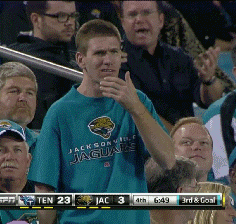
I don't know how the rock worked, but it's clear from a careful analysis of the manuscript that Joseph did not know in advance what the text was going to say. He hadn't memorized it. He was not making it up because he didn't know what was going to be there. Chapter breaks and book divisions apparently surprised him. He would see some indications, evidently, of a break in the text. In each case he would tell his scribe to write "chapter." The numbers were then added later. For instance, what we now recognize as the end of First Nephi in the original manuscript indicates that a new chapter is about to begin. In the original chapter divisions that upcoming text was marked as "Chapter 8" (Roman numerals). When Joseph and Oliver subsequently discovered that they were instead at the opening of a wholly distinct book, second Nephi, the chapter heading was crossed out, and a more appropriate heading was inserted. This is quite instructive. It indicates that Joseph could only see the end of a section, but did not know if the next section would be another portion of the same book, or rather the commencement of an entirely new book altogether.
There were other things that, again, I'm going to summarize because I'm short on time. There are other things that caught him by surprise. He couldn't pronounce the names in some cases. He would have to spell them out. Or there are times when he asked a question, like "Emma, did Jerusalem have a wall around it?" He's surprised. And she says, "Well, yes, I think it did," and he says, "Oh, good. I thought maybe that I was being deceived." Because the cities he knew, Palmyra, didn't have walls around them, certainly not like Arnold Friburg's.
Here's the bottom line: Thus we see that Joseph Smith appears to have been reading from something external to himself, but that he had no book, or manuscript or paper with him. It seems to have been a text that was new and strange to him and one that required a certain emotional and mental focus for it to be read. You know, it also seems to have required the exclusion of circumambient light so he could see it clearly because he was doing this multiple hours a day like looking at a computer screen. Your eyes begin to give out, especially if there's a glare behind the computer. People typically don't put a computer up against a plate glass window where the sun is shining, right? Because you want to see it more clearly. He had to be in mental or emotional focus to be able to work on it and so on. All this is entirely consistent with Joseph's claim that he was deriving the text by revelation by the power of God through an interpreting device, but does this seem reconcilable with the idea that he smuggled in the Spalding manuscript, or something like that?
The facts that there are exact and obscure 1769 KJV edition errors and 17th century KJV italics present in the Book of Mormon completely contradicts and obliterates Peterson's "he had no book, or manuscript or paper with him" claim.
Unless Peterson has the audacity of pointing to God Himself as the Source for giving Joseph exact and obscure 1769 KJV edition errors and 17th century KJV italics to put into the "most correct book on earth," - which claims to be a translation of ancient writings of ancient inhabitants of the Americas - the damning physical evidence soundly debunks Peterson's claims.
Here's another issue: The First Vision.

All sorts of criticism in the Letter to a CES Director about the First Vision accounts, but there's no serious engagement with people who have responded to the issues. No serious engagement with Jack Welch's work on the topic, or the earlier work of Milt Bachman, Richard Lloyd Anderson or Richard Bushman, for example. No sign of it.
Again, Peterson continues to demonstrate his lack of understanding of the CES Letter, its background story and its purpose. As mentioned, the letter was not a thesis paper analyzing the contradictory opinions and pet theories of Mormon apologists. It was seeking official answers from the Church through its CES Director.
Peterson ignores my CES Letter statement: "I'm hoping you're going to have better answers than many of the ones given by unofficial apologists such as FAIR and Neal A. Maxwell Institute (formerly FARMS)."
And again, Peterson completely ignores Debunking FairMormon, which is an extension and expansion of the CES Letter in which I go into meticulous detail on the various issues. In fact, my First Vision section in which I demonstrate the inconsistencies and contradictions of the multiple First Vision accounts can be read here.
Here's one I want to spend a little more time on. There's Book of Abraham Facsimile 1.
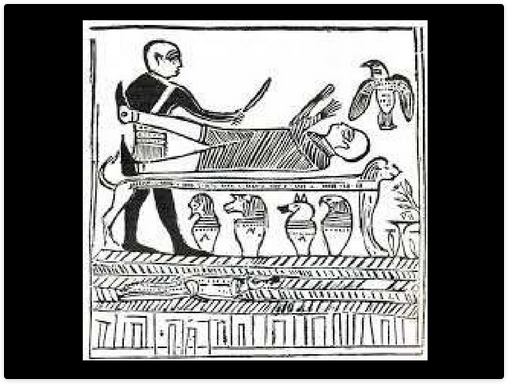
This is the ninth objection that I've chosen to look at.
"Of all of the issues, the Book of Abraham is the issue that has both fascinated and disturbed me the most. It is the issue that I've spent the most time researching, because it offers real insight into Joseph's modus operandi, as well as Joseph's claim of being a translator. It is the smoking gun that has completely obliterated my testimony of Joseph Smith and his claims."
Now I wrote an article years ago. I can't claim it was original. I did it as kind of a collective statement on behalf of people that were associated with me at what became the Maxwell Institute/FARMS called News from Antiquity. It published in January 1994 in the Ensign, where I laid out kind of a consensus view of things about the ancient world that the Book of Abraham gets right. There's no notice of that. It's not only authorial pride, I'm just irritated that the issue is not addressed. But, he goes on to say things like this: "The Book of Abraham teaches a Newtonian view of the universe. Its Newtonian astronomy concepts, mechanics, and models of the universe have been discredited by 20th century Einsteinian physics." Now, that irritated me too because John Gee, Bill Hamblin, and I wrote a piece a number of years ago published in a volume by the Maxwell Institute in which we argued that the Book of Abraham makes sense not as Newtonian physics, but as a geocentric model of the cosmos. It is, in my view anyway, not Newtonian physics. But that article, even if you think it's wrong, is not even noticed. It's just this naive idea that it's representing the kind of physics that Joseph Smith would have known in the 19th century and that it therefore discredits Joseph. But the Book of Abraham actually works really well as a kind of primitive geocentric astronomy, the kind that you might have understood in Egypt, the kind that would have been comprehensible to Abraham at that period. It has the earmarks of antiquity on it, to me.
Again, Peterson demonstrates his lack of understanding of the background story and purpose of the CES Letter.
In one of Peterson's articles that he co-wrote with his fellow apologists, Peterson argues that the Book of Abraham "makes sense not as Newtonian physics, but as a geocentric model of the cosmos."
Peterson's theory and opinion is not widely accepted nor is it considered authoritative even among LDS circles. In yet another example that Mormon apologists cannot agree among themselves, LDS astronomers Michael D. Rhodes and J. Ward Moody reject Peterson's theory as they believe there is harmony between the astronomy in Abraham 3 and modern heliocentric astronomy. As Mormon scholar Brian M. Hauglid wrote:
Runnells points out in his letter that the physics in Abraham 3 is outdated. Some LDS scholars have noticed this as well. John Gee, William J. Hamblin, and Daniel C. Peterson have argued that the geocentric universe described in Abraham 3 can be explained on the basis that Abraham is describing the visible heavens and not the entire universe. Astronomers Michael D. Rhodes and J. Ward Moody, on the other hand, suggest that there is harmony between the astronomy in Abraham 3 and modern heliocentric astronomy. I don't know of any non-LDS astronomers weighing in on this issue.
To illustrate just how vastly different these two apologists see Book of Abraham astronomy, we need to understand the difference between geocentric and heliocentric models. Geocentric = Earth at center of the universe with Sun, Moon, stars, and planets circling it. Heliocentric = Sun is center of solar system with Earth and planets orbiting sun. More importantly, Einstein's Theory of Relativity upsets both models.
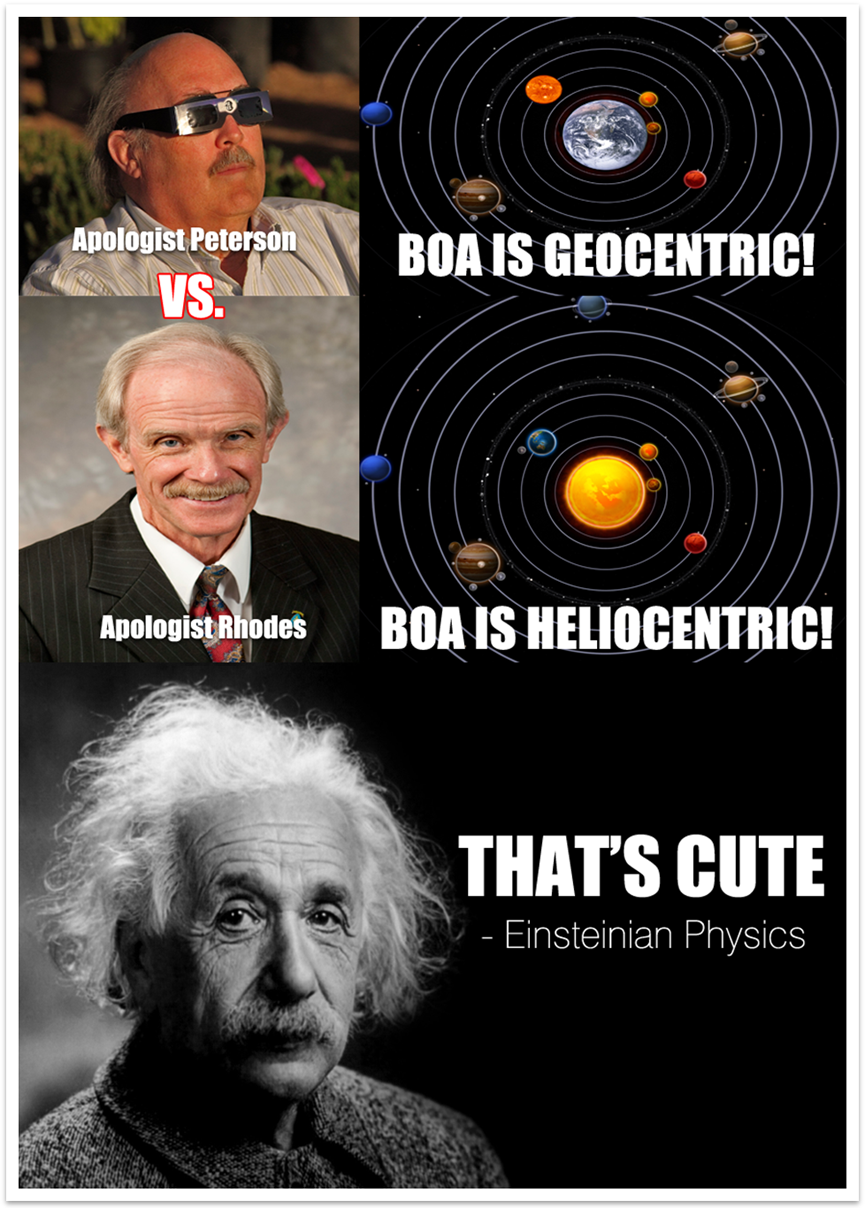
How was I supposed to include apologetic pet theories and opinions in the CES Letter when there are so many of them that contradict each other? In Peterson's universe, not including poorly devised and contradictory unofficial Mormon apologetic theories in a personal Letter to a CES Director seeking official answers is one-sided and "wearisome reading."
What we find in Abraham 3 reflects a Newtonian world concept. The Catholic Church's Ptolemaic cosmology was displaced by the new Copernican and Newtonian world model, just as the nineteenth-century, canonized, Newtonian worldview is challenged by Einstein's twentieth-century science.
Keith Norman, an LDS scholar, has written that for the LDS Church, "It is no longer possible to pretend there is no conflict."
Norman continues:
Scientific cosmology began its leap forward just when Mormon doctrine was becoming stabilized. The revolution in twentieth-century physics precipitated by Einstein dethroned Newtonian physics as the ultimate explanation of the way the universe works. Relativity theory and quantum mechanics, combined with advances in astronomy, have established a vastly different picture of how the universe began, how it is structured and operates, and the nature of matter and energy. This new scientific cosmology poses a serious challenge to the Mormon version of the universe.
"Many of the astronomical and cosmological ideas found in both Joseph Smith's environment and in the Book of Abraham have become out of vogue, and some of these Newtonian concepts are scientific relics. The evidence suggests that the Book of Abraham reflects concepts of Joseph Smith's time and place rather than those of an ancient world." - Mormon historian and scholar Grant Palmer, An Insider's View of Mormon Origins, p.25
Peterson writes:
"the Book of Abraham actually works really well as a kind of primitive geocentric astronomy, the kind that you might have understood in Egypt, the kind that would have been comprehensible to Abraham at that period. It has the earmarks of antiquity on it, to me."
Peterson tries to hand wave the generally accepted Newtonian worldview clearly on display in the Book of Abraham for his strange "kind of primitive geocentric astronomy." The Book of Abraham is looked at as scripture containing revealed eternal truths from God to Abraham but here Mormon apologist Peterson is arguing that the astronomy given is "primitive" and "the kind that you might have understood in Egypt" and "the kind that would have been comprehensible to Abraham in that period."
In other words, the inaccurate and incorrect astronomy is all on Abraham's head and because this "kind of" incorrect and inaccurate "primitive" astronomy could have been "the kind that you might have understood in Egypt," it has, in Peterson's universe, "the earmarks of antiquity on it."
Slam dunk for Joseph Smith.
Here's what I don't understand: Why did God reveal an inaccurate and "primitive" geocentric universe to Abraham that has been made obsolete by 20th century Einsteinian physics?
Perhaps for the same reason He revealed 1769 edition KJV errors through a rock in a hat?
The letter goes on to say this: "He names," speaking of Joseph Smith,
"He names gods that are not part of the Egyptian belief system, of any known mythology or belief system." "Joseph Smith got everything wrong about the papyri, the facsimiles, the names, the gods...it's gibberish."
Now, the Book of Abraham is anything but gibberish. I mean, just try reading it. It's not gibberish. It's a very impressive little book. It's not true the names of the gods cannot be connected at all with the ancient Near East. There are several articles on this showing plausible identities for those gods, but I want to look more closely at one particular case.
This is an image of the syncretized god Sobek-ra, the crocodile god of the middle kingdom, with Pharaoh Amenhotep III. It's a larger than life-sized statute.

Some of you may have been in Luxor, Egypt. It stands right in the entry lobby of the museum there in Luxor. One noteworthy element of the religious situation portrayed in the Book of Abraham is the identification of a crocodile as the idolatrous god of Pharaoh, right there underneath the lion couch. That's a kind of odd thing to come up with if you're a yokel farm-boy from upstate New York. Is that the first thing that comes to your mind? Oh, idolatrous god of Pharaoh!
Although this may have seemed strange in Joseph Smith's day, discoveries in other ancient texts confirm this representation. Unas or Wenis, for example, was the last king of the fifth dynasty, around 2300 B.C., and his pyramid still stands at Saqqara, south of modern Cairo. Utterance 317, Unas' pyramid texts, includes the following: "The king appears as the crocodile god Sobek, and Unas has come today from the overflowing flood. Unas is Sobek, green plumed, wakeful, alert...Una arises as Sobek, son of Neith. One scholar observes that "the god Sobk is...viewed as a manifestation of Horus, the god most closely identified with the kingship of Egypt" during the Egyptian Middle Kingdom era (around 2000 B.C., maybe a little later), which includes the time period that tradition indicates is Abraham's time.
Intriguingly, Middle Kingdom Egypt saw a great deal of activity in the large oasis to the southwest of modern Cairo known as the Faiyum. Crocodiles were common there. You know what the name of the place was to the Greeks? The major town there was called "Crocodileopolis."
Does that give you a clue? Crocodiles were common there and Sobek was the chief local deity. The [wife of the] last king of the 12th Dynasty, which may include the period of Abraham's life, even adopted the name of the crocodile god, calling [herself] Nefru-Sobek. 4 ("Beautiful is Sobek"). And five pharaohs of the next dynasty, the 13th, took the name Sebek-hotpe ("Sobek is content").
He got everything wrong about the facsimiles, right? That's just not true.
I break down and respond to Peterson's above claims and statements below:
Peterson says: "The letter says, "Joseph Smith got everything wrong about the papyri, the facsimiles, the names, the gods...it's gibberish."
"Now, the Book of Abraham is anything but gibberish. I mean, just try reading it. It's not gibberish. It's a very impressive little book."
This is a strawman fallacy as Peterson is misrepresenting my argument.
I did not say the Book of Abraham's text or its story is gibberish. I simply wrote, "Joseph Smith got everything wrong about the papyri, the facsimiles, the names, the gods...it's gibberish."
Peterson says: "It's not true the names of the gods cannot be connected at all with the ancient Near East. There are several articles on this showing plausible identities for those gods, but I want to look more closely at one particular case."
Not only does Peterson not cite the "several articles" he points to as backup for his claim but take note that these mysterious articles are not proving or pointing to actual gods but rather showing "plausible identities for those gods." In Mormon apologetics, it's all about plausibility...no matter how irrational or unlikely.
Regardless, Peterson has one god that we should all take a closer look at as home run for Team Joseph: the crocodile god Sobek, a war god and lord of semen.
Ironically, Mormon Egyptologist Stephen E. Thompson and other Egyptologists identify this crocodile instead as representing the god Horus. While Sobek is often portrayed in the form of a crocodile, in the case of this re-enactment of the Osiris-myth, it would be more appropriate to identify this figure as Horus. As Egyptologist Klaus Baer noted:
The versions of the Osiris myth differ in telling how Seth disposed of Osiris after murdering him, but he was commonly believed to have cut Osiris into little pieces, which he scattered into the Nile, leaving Isis the task of fishing out and assembling the parts of her brother and husband so that he could be resurrected and beget Horus. In this she was helped by Horus in the shape of a crocodile, which is represented in the water (the zigzags) below the vignette...
Moller...discusses the occasionally attested practice of having a small (and prudently muzzled) crocodile swim alongside the boat carrying the mummy across the Nile to the cemetery.
Peterson wrote in the January 1994 Ensign about how Nefru-Sobek was an Egyptian King and crocodiles are an accurate representation of Pharoah. In his FairMormon presentation, he simply reads exactly what he said in 1994. Peterson had to be corrected as Nefru-Sobek is an obscure queen, not a king. Furthermore, it is an extremely poor argument because the military god Sobek represented through the crocodile symbol is simply one of seventy Egyptian Deities and bears little resemblance to Joseph Smith's guess. And this is Peterson's best example that Joseph didn't get everything wrong with the facsimiles.
Even if we concede Peterson's claim that Joseph was correct on Facsimile 1 #9 "The idolatrous god of Pharaoh"? Joseph still translated an astounding 97.4% of all 3 Facsimiles wrong.
Out of 39 of Joseph's facsimile translations, Joseph is correct: 1
Out of 39 of Joseph's facsimile translations, Joseph is incorrect: 38
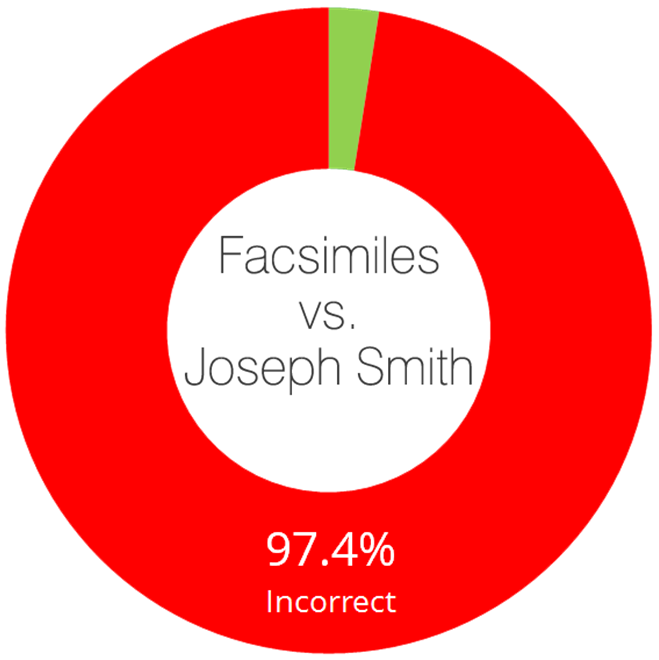
It is a sad and illuminating testament indeed that the best defense that a top Mormon apologist can come up with for Joseph on the facsimiles is that Joseph didn't get everything wrong as he may have gotten one right!


It is well worth posting here the following infographics for each Facsimile to remind us all just how wrong Joseph Smith's "translations" are:
Respected Egyptologist, Robert K. Ritner, Ph.D. – has debunked every apologetic claim for the Book of Abraham and that Joseph Smith translated from ancient egyptian papyri:
"If you took a painting of Madonna and Child and you tore off the heads of both figures and you replaced them with a dog and a cat, it would be as obvious to us now that this is wrong as the replacing of the clearly jackal head with a human head on this Egyptian piece because we know what these images actually look like. In the same way, we know that those figures would – never under any circumstance – hold a knife. And that’s critical to the text itself (Book of Abraham) because it’s not merely decoration for this text. It goes to the core of the supposed story that accompanies it. If you take the knife away, you take away the story as well. And clearly the knife had no reason to be there."
- Dr. Robert K. Ritner, Ph.D., University of Chicago
Dr. Ritner later did a groundbreaking 3-part interview in 2020 with Mormon Stories going over the Book of Abraham. This series is worth its weight in gold:
Part 1
Part 2
Part 3
To read Dr. Ritner's direct response to the Church's July 2014 Translation and Historicity of the Book of Abraham essay: PDF.
The follow video is an excellent summary of the topic:
I go into detail on all of this in the Debunking FairMormon Book of Abraham page here.
Polygamy is a big issue for the Letter to a CES Director too, but what's noteworthy to me is the things that are not engaged. And I just mention a couple of recent things, but these represent work that's been done over the past decade or so on polygamy. This is a book by Newell Bringhurst and Craig Foster called Persistence of Polygamy.
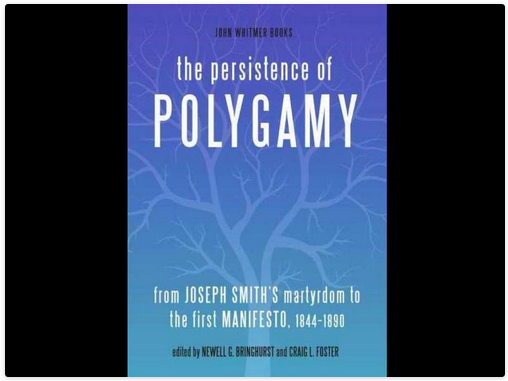
At least three of the essays in that particular volume are directly relevant to charges made in the letter, but it doesn't address them. Here are the three volumes of Brian Hales' massive work on Joseph Smith's polygamy, again, essentially unaddressed.
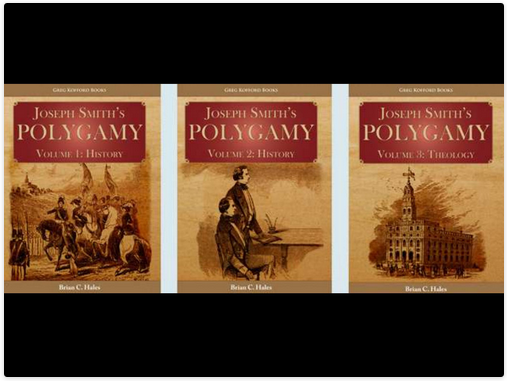
Here's the website that Brian and Laura Hales are now doing where a lot of these issues are discussed [josephsmithspolygamy.org]. No engagement with this or with anything, as far as I can see, that they put forward.
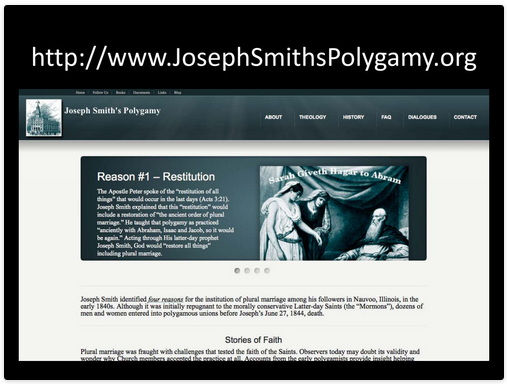
Again, the common theme in Peterson's presentation is his fundamental misunderstanding and misrepresentation of the CES Letter, its background story and what the intended purpose of the CES Letter was. Peterson fails to understand that the letter was just that - a letter to a CES Director seeking official answers to the problems.
It was not a thesis focused on summarizing the contradictory pet theories and opinions of unofficial Mormon apologists.
Again, Peterson completely ignores Debunking FairMormon, an extension and expansion of the CES Letter where I actually address and go into meticulous detail into the issues. In fact, I have written about some of Hales' work and conclusions in the Polygamy/Polyandry section of the site.
The fact that Peterson is pointing to Brian C. Hales' work as a source for answers on the serious problems of Joseph Smith's polygamy and polyandry should be disturbing to believing Latter-day Saints. It is a troubling testament indeed of how the Church and its apologists do not have reasonable answers to the serious problems of Joseph Smith's polygamy and polyandry.
I am aware of Hales' work, his interpretations and his conclusions. I find - along with most in the polygamy scholarly community - Hales' books to be well-researched (thanks to his assistant scholar Don Bradley) but Hales' personal apologetics and opinions on this topic to be extremely disturbing, illogical, immoral and inaccurate based on the data.
Brian Hales mentions that scholars may critique his work. Some of Hales' own work was critiqued by historian and scholar D. Michael Quinn in 2012 and 2013 and what Quinn had to say about Hales’ conclusions isn’t encouraging. Aside from important weaknesses and incorrect arguments, Hales’ work is full of red herrings, flawed methodology and manipulation of the evidence. And it is important to note that Quinn only reviewed Hales’ conclusions about sexual polyandry in Joseph Smith’s marriages.
D. Michael Quinn found a plethora of problems with Hales' approach as an historian. Here are just some of the problems:
"With regard to my making such stark assessments about Brian C. Hales, I have praised him throughout this 'expanded-finalized' monograph as 'an honest apologist' whenever I can, but I cannot remain silent about the perplexing gaffes in his use of evidence."
D. Michael Quinn, Mormon Historian and Scholar
Evidence for the Sexual Side of Joseph Smith's Polygamy, p. 73-74
Other Mormon scholars and historians share their assessments of Brian Hales:
"While I find Brian Hales' works well-researched, I don’t find them well-reasoned. He likes to accuse Palmer of overstating his case, but he constantly quibbles, minimizes, and understates the evidence."
Dan Vogel, Mormon Historian and Scholar - Mormon Stories Interview comment
"Make no mistake about it: this is apologetics. Hales is committed to making Joseph Smith look as clean as a whistle. To do this, he is obliged to paint some witnesses as unreliable, extravagant, and anti-Mormon; yet, somewhat inconsistently, he is willing to accept statements from these or like characters when they support his claims. Hales’ polemical concerns drive him to defend a number of difficult positions."
"While his discussion of Joseph Smith's practice of polygamy may be hard for many ordinary members of the Church, what Hales has to say about that practice [polygamy / polyandry] is similarly problematic among many LDS historians."
"After a careful reading of volume 1, I suggest that the jacket remarks by Bushman, Compton, and Foster are insightful, accurate and understated. Hales doesn’t always analyze his data in useful ways; he argues positions which presentation of evidence in later chapters appears to contradict; he qualifies arguments in ways which seem driven more by agenda than demanded by the evidence."
"I do not agree that Hales interprets history responsibly. His history, rather than being descriptive, is prescriptive. He tells the reader how they should interpret the evidence rather than letting the evidence speak for itself. I find this throughout the volumes. It is in his handling of the evidence that he and I will have to agree to disagree. In many places, his own evidence overwhelmingly supports interpretations at variance with those he himself provides."
Cheryl L. Bruno, Mormon Polygamy Scholar and Historian
First Thoughts on Joseph Smith's Polygamy by Brian Hales - Worlds Without End
Joseph Smith's Polygamy - A Response to Brian Hales
"Brian Hales wants to face up to every question, every problem, and every fear about plural marriage. His answers may not satisfy everyone, but he gives readers the relevant sources where answers, if they exist, are to be found. There has never been a more thorough examination of the polygamy idea."
Richard Bushman, LDS Scholar
Back book cover of Brian Hales' book
"Joseph Smith's Polygamy, the first thorough treatment of Joseph Smith's plural marriages written by a conservative Mormon scholar, is a landmark in the historiography of Mormon polygamy. While I disagree with some of Hales's conclusions, I admire his willingness to confront difficult topics and the depth of his research. This impressive work furthers the ongoing dialogue in the Mormon historical community on a fascinating and challenging aspect of the life and teachings of Mormonism's founding prophet."
Todd M. Compton, Mormon Polygamy Scholar
Back book cover of Brian Hales' book
"Brian Hales is an exceptionally thorough, meticulous, and evenhanded researcher and assessor of Joseph Smith's complex and controversial polygamous practices and the theological rationale that supported them. His path-breaking and indispensable three-volume study provides the most comprehensive documentation and assessment yet available of the extant evidence on the topic, even though Hales's fellow scholars of Joseph Smith's polygamy may not always find persuasive the ways in which he interprets and contextualizes his evidence."
Larry Foster, Mormon Polygamy Scholar in 2013
Back book cover of Brian Hales' bookThe following is a more recent interview with Professor Foster in which he shares more candid views of Brian Hales' methodology and work:
The following is FairMormon's and Brian Hales' own graphic comparing ostracized Brian Hales to other polygamy scholars on the subject of sexual polyandry. Notice that Brian stands alone in his claim that Joseph didn't have sex with his wives who were also married to other living men:
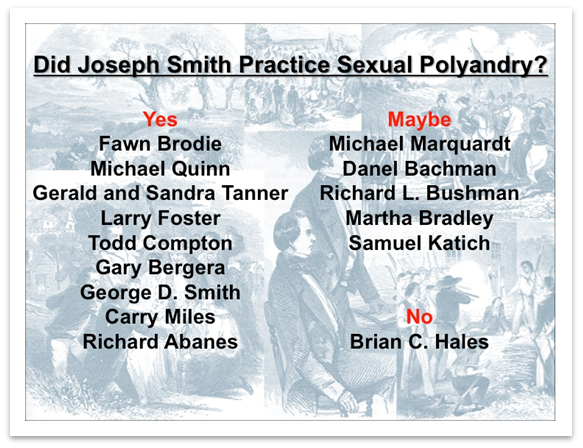
The following amazing and extremely well done 3-part series by Mormon historian/scholar Dan Vogel carefully dismantles Brian Hales' apologetics and claims on Joseph Smith's polygamy and polyandry.
As one commentor states about the following presentations by Vogel:
"I think this video series might be the nail in the coffin in the whole 'Joseph wasn't having sex with his polyandrous wives' argument. Highly recommended."
Joseph Smith and Other Men's Wives - Part 1
Joseph Smith and Other Men's Wives - Part 2
Joseph Smith and Other Men's Wives - Part 3
A detailed rebuttal to Brian Hales' attacks against me and the CES Letter will be launched soon:

The author of the letter then attacks the witnesses. And one of the things that is now done, the newly fashionable way of addressing the witnesses to say, "Well, these were primitive people, you know, of a different era. They really couldn't distinguish reality from fantasy." And so, there was an article that Richard Lloyd Anderson wrote for the old Journal of Book of Mormon Studies.

I confess, I was the one who provoked him into doing it. I pestered him, and pestered him and pestered him for about two years, because I thought this article was necessary: "Attempts to Redefine the Experience of the Eight Witnesses." The eight witnesses were explicit in many cases. They held the plates. They saw them. Hyrum Smith said, "With these eyes...I held them with these hands." And then I hear people say, "Well, they never really claimed to see them with their natural eyes." What? What more could they say? It's like they're directly addressing these critics today. But those sorts of statements are ignored in favor of often second- and third- and fourth-hand statements suggesting they never actually saw or touched the plates at all.
This is what he says, the author of the letter:
"The mistake that is made by 21st century Mormons is that they're seeing the Book of Mormon Witnesses as empirical, rational, nineteenth-century men instead of the nineteenth-century magical-thinking superstitious and treasure-digging men they were."
I confess, as someone who has spent a lot of time, much of my life, looking at people from pre-modern periods, that the sheer condescension of this, the chronological smugness and complacency of that statement irritates me, and not merely because I'm a believing Latter-day Saint. It's rather like someone to ascribe early Christian belief to the resurrection of Jesus to the supposed fact that ancient people, unlike us, hadn't yet realized that dead people tend to stay dead, which, if it were true at all, would leave us wondering why they thought the resurrection of Jesus was such a big deal. Happens all the time, right?
But recently the preferred method of dealing with the witnesses is simply to say that they are primitive and superstitious and so on. But, here's a paragraph I wrote some years ago, a couple of paragraphs, and I'm going to read them because I'm fond of them. Some of you may have heard it before, but I think the point needs to be made:
It seems implausible to assume that the witnesses, early nineteenth-century farmers who spent their lives rising at sunrise, pulling up stumps, clearing rocks, plowing fields, sowing seeds, carefully nurturing crops, herding livestock, milking cows, digging wells, building cabins, raising barns, harvesting food, bartering, in an often cashless economy, for what they could not produce themselves, wearing clothes made from plant fibers and skins, anxiously watching the seasons, and walking or riding animals out under the weather until they retired to their beds shortly after sunset in "a world lit only by fire," that they were estranged from everyday reality.
It's especially unbelievable when the claim is made by people whose lives, like mine, consist to a large extent of staring at digital screens in artificially air-conditioned and artificially lit homes and offices, clothed in synthetic fibers, commuting between the two in enclosed and air-conditioned mechanical vehicles while they listen to the radio, chat on their cell phones, and fiddle with their iPods, whose inner workings are largely mysterious to them, who buy their prepackaged food (with little or no regard for the time or the season) by means of plastic cards and electronic financial transfers from artificially illuminated and air-conditioned supermarkets enmeshed in international distribution networks of which they know virtually nothing, the rhythms of whose daily lives are largely unaffected by the rising and setting of the sun. Somehow the current generation seems ill-positioned to accuse the witnesses' generation of being out of touch with reality.'
And, I think of Martin Harris with the plates at one point, before he is actually a witness, [the plates are] sitting on his lap in a box. He hasn't seen them, but he can feel them. You know, rocks are heavy, but lead is heavier, right? And gold is heavy. And sometimes, the box is just too small to be full of rocks. It wouldn't be as heavy as it was, and he said, he was sitting there thinking these are really heavy and I knew that they had to be either lead or gold, and I knew that Joseph didn't have enough credit to get so much lead. I've always thought that was a funny comment. Yeah, so it's obviously gold, as a matter of fact, it was. But that scarcely seems mystical or estranged from reality to me.
And then you have the Smith women feeling the plates, hearing them rustle against one another. These are not mystical visionary experiences. This is matter-of-fact stuff. Cleaning the house they have to move the darn plates. They're 60 pounds. I'm very impressed with the witnesses. They cannot be brushed aside as easily as all that.
I emailed one of the world's foremost experts and scholars on the Book of Mormon witnesses and early Mormonism, Dan Vogel, who is cited more than any other author in respected LDS scholar Richard Bushman's Rough Stone Rolling. Mr. Vogel has kindly and graciously emailed me back his rebuttal to Daniel C. Peterson:
As requested, I will now give my comments on Peterson's remarks about the Book of Mormon witnesses. Of course, Peterson fails to mention my response to Anderson's essay, which was a response to my essay on the witnesses in American Apocrypha. The point Peterson and Anderson don't get is that the printed testimonies of the three and eight witnesses are not reliable for reconstructing the historical events behind them. A detailed examination of the Testimony of Three Witnesses against subsequent statements of Harris and Whitmer makes it abundantly clear that the relationship between the document and event, or rather events, is superficial and misleading. While our information about the experiences of the eight witnesses is not as plentiful, there is significant evidence that it was at least partly visionary.
It is disingenuous for Anderson and Peterson to quote some of the eight witnesses affirming their testimony as if it were supportive of their superficial reading of the document. That's an interpretive loop. Rather, when John Whitmer told Theodore Turley in 1839 that the plates were shown to him by a "supernatural power" or Martin Harris revealed in a public meeting in 1838 that the eight witnesses did not see the plates with their natural eyes, we should read the published Testimony in that light. To resolve the issue of handling the plates and seeing them in vision, I prefer to use the model provided by Harris. He said in 1838 that he saw the plates with spiritual eyes while they were covered with a handkerchief.
Peterson criticizes Jeremy (and Grant Palmer) for trying to contextualize the witnesses' experiences. It shouldn't be the 19th vs. 21st century, but rationalist vs. supernaturalist mindset, which existed then as it does now among certain groups. Don't forget Joseph Smith lived in the age of enlightenment and skepticism, on one hand, and the irrational/emotionalism of the revivals as well as the supernaturalism of the magic worldview, on the other. Joseph Smith and the witnesses belonged to a subculture that permitted cultivation of anomalous experience. While Peterson is right to criticize this 21st century bias, he makes the opposite mistake in arguing that farmers and laborers wouldn't succumb to hallucination. However, Peterson is right to criticize anyone espousing a theory that does not account for the casual witnesses who lifted the plates and heard them rustle with metallic sound in a box or wrapped in a cloth.
Peterson hasn't thought through the implications of Harris's statement to Tiffany in 1859 that the box contained either lead or gold, while at the same time saying the plates weighed about sixty pounds. Lead would weigh over a hundred pounds and gold much more. Harris wasn't the great investigator he imagined himself to be-and that was his downfall.
Dan Vogel's fantastic two-part documentary analyzing the Book of Mormon Witnesses is well worth watching:
Here's a picture of James Jesse Strang.
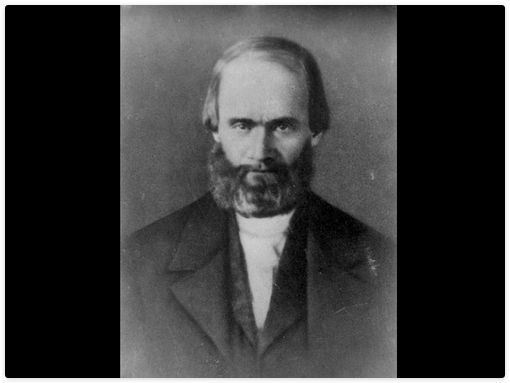
The author of the letter brings up the Strangite witnesses and says that they are basically the same kind of thing that Joseph had. I'm just going to summarize what I have written here in order to go through it more quickly. The Strangite witnesses never claim a supernatural experience, several of them apostatized, several of them said, "You know, it looked to me like Strang probably made them." No one doubts they existed. The question is where did they come from? He put them on display and people looked at them and they said, "It looks like the kind of stuff you make a teapot out of." This is probably what it was. These are not very impressive witness testimonies, and it took Strang ten years to produce his book. Joseph dictated his in two months. I mean, at every point the contrast works in Joseph Smith's favor, it seems to me.
The above statements and claims by Peterson are especially disingenuous. I quickly break them down and respond to each one of them below:
Peterson says: "The Strangite witnesses never claim a supernatural experience, several of them apostatized, several of them said, "You know, it looked to me like Strang probably made them."
Peterson made similar claims that the Strangite Witnesses denied their testimonies of the plates in his "Defending the Faith: the story behind James Strang and his sect". In fact, Peterson stated in his article, "One source reports that most of the four witnesses to the Rajah Manchou plates ultimately repudiated their testimonies." What Peterson fails to tell his readers about this source is that this source also asserts that the Book of Mormon witnesses likewise repudiated their testimonies of the Book of Mormon. Apparently, however, this is not a problem to Peterson since the "good" portions of this source works nicely with his agenda of "discrediting" the Strangite witnesses.
Mormon apologists would immediately cry foul and demand evidence and sources to back up the claim that the Book of Mormon witnesses denounced. Why then is Peterson operating under a completely different standard than would be expected - even demanded - if the tables were turned?
I discuss this in more detail here.
Book of Mormon Witnesses scholar Dan Vogel wrote:
Peterson's appeal to Strang's plates is most effective against anyone who thinks Joseph Smith made a set of plates and then presented them to the eight witnesses for viewing. This would be a difficult position to defend. I have referred to the multiple witnesses for the shaker roll, who saw an angel holding it. Again, the best model is Harris' seeing the plates with spiritual eyes while it was in the cloth - like a city through a hill, as Bernett reported in 1838.
Peterson says: "it took Strang ten years to produce his book. Joseph dictated his in two months. I mean, at every point the contrast works in Joseph Smith's favor, it seems to me."
This is false. Joseph had 6 years to come up with the text and plot for the Book of Mormon. Joseph's mother, Lucy Mack Smith, wrote in her autobiography about Joseph in 1823:
"During our evening conversations, Joseph would occasionally give us some of the most amusing recitals that could be imagined. He would describe the ancient inhabitants of this continent, their dress, mode of travelings, and the animals upon which they rode; their cities their buildings, with every particular; their mode of warfare; and also their religious worship. This he would do with as much ease, seemingly, as if he had spent his whole life among them."
General Authority and scholar Elder B.H. Roberts agrees with Lucy Mack Smith's imagination assessment as he wrote:
"...was Joseph Smith possessed of a sufficiently vivid and creative imagination as to produce such a work as the Book of Mormon from such materials as have been indicated in the preceding chapters [View of the Hebrews, etc.]...? That such power of imagination would have to be of a high order is conceded; that Joseph Smith possessed such a gift of mind there can be no question." - Studies of the Book of Mormon, p.243
There are many, many books - far superior in writing style, story line and character development - that didn't take nearly as long as the Book of Mormon did to complete.
LDS Historian and scholar Grant Palmer wrote:
"Perhaps the outline of a book began to form sometime before Martin Harris became his scribe in April 1828. He had already experimented with seer stones, and perhaps he thought that through greater faith and concentrations, God would open to his mind a vision of the secrets of the artifacts being discovered in upstate New York. The dictation proceeded, and after Martin lost the first 116 pages of transcription in mid-1828, this may have been fortuitous. An apprenticeship had been served, and the vision that was unfolding in Joseph's mind may have become more clear. The dictation probably progressed haltingly at first, perhaps as a kind of stream-of-consciousness narrative. Before Oliver Cowdery became his new scribe in April 1829, the prophet had had nine months to ponder the details of the plots and subplots and to flesh out the timeline. Given his familiarity with the Bible and with American antiquities, it would have become progressively easier for him to put form to vision. He dictated the final manuscript in about ninety days. Over the next eight months, before the book was published in March 1830, he had the opportunity to make textual refinements. He thus had three years to develop, write, and refine the book - six years from the time he told his family about the project." - An Insider's View of Mormon Origins, p.66-67
There are a lot of truths and myths about the Book of Mormon itself. Some of the myths which have penetrated the minds of millions of Latter-day Saints over the past few generations continue still today in the Church's CES system and missionary program. One of these myths is Mormon apologist Hugh B. Nibley's Book of Mormon Challenge, which can be read and analyzed here.
Ok, well, the letter goes on, and on, and on, and on, and on, and on. Everything is thrown in: The Paul Dunn story, the Salamander Letter, Church finances, the September Six. The author dislikes the temple, thinks it's silly.

Well, I wonder: OK, is that the attitude before deconversion? That would be interesting. Or is that the attitude afterwards? In which case, well, that says something too. But frankly, to be honest, I ran out of patience. Ninety pages - it was boring as could be. So, I want to recommend some things. I don't like just playing defense, so I want to be really quick and some of you have heard me say this before. I'm going to keep beating this drum because I see casualties all the time.
Unfortunately, Peterson's above ad hominem provides zero substance.
Peterson's answer on Paul Dunn? ((crickets chirping))
Peterson's answer on Salamander letter? ((crickets chirping))
Peterson's answer on lack of transparency in Church finances? ((crickets chirping))
Peterson's answer on September Six? ((crickets chirping))
Peterson's answer on Temples and Freemasonry? "Author dislikes the temple, thinks it's silly" followed by mischaracterization of my attitude and belief toward the Temple as a member. Peterson doesn't know me nor can he possibly know what my attitude toward the Temple was as a believing member.
I actually loved the Temple as a believing member. I went as often as I could before my mission and I attended almost on a weekly basis when I came home from my mission as my family's home was less than a mile away from one. I attended the Temple often as a student at BYU and tried to attend during the insane early marriage/parenthood years. In my last Temple attendance in the Salt Lake Temple during my faith crisis/transition, I stood on the stairs in the Celestial room in tears as I looked around the near empty room (having been the last person in the session still standing) because I knew that it was going to be the last time I would ever be in a Temple again. It was like saying goodbye to a friend on his deathbed.
So, I reject Peterson's mischaracterization of me and the Temple.
It's unfortunate that Peterson wasted away an opportunity to explain and resolve the problems of the Temple for his audience but instead chose to shift focus to me and what my opinion of the Temple was.
Peterson thinks the letter is "boring as could be." Peterson isn't my intended audience. In fact, I indirectly call out Peterson and unofficial apologists like him in the CES Letter for doing more to destroy my testimony than any anti-Mormon source ever could. So, I had zero expectations that Peterson and his apologist buddies would find the CES Letter anything other than "boring," "amateurish" and "wearisome." After all, the CES Letter is directly attacking Peterson's baby and life's work (Mormon apologetics).
I didn't write this letter to an unofficial Mormon apologist whose career (and paycheck) is dependent upon finding any plausible answers to keep the party going. I wrote this letter to a CES Director seeking official answers. The ones who do not find the letter boring are those seekers, who are honest in heart, wanting to know the facts that the Church has concealed from them their entire lives. They're the ones emailing me on a daily basis thanking me for making the information transparent and open. They're the ones who do not find the letter "boring as could be."
It is not enough to simply play defense. If you're playing a football game and your defense is always on the field, you're probably going to lose. They might occasionally get an interception or a fumble, and score, but probably you're going to lose. Likewise, a metaphor I heard the other night from John Lynch was that we are often trying to fill in the holes experienced in testimony. Well, if we fill them in, we just bring them back up to normal ground level. That not enough. We want to build things up. There are lots of metaphors you could use. If we're always just putting out fires, you're going to miss one. You know, eventually you're going to miss a fire. So, build conditions where the fires don't happen. Soak your lawn.
Peterson then recommends the following books as a means for "soaking your lawn" in protecting and "saving" Mormon testimonies:
Richard Anderson's Investigating the Book of Mormon Witnesses:
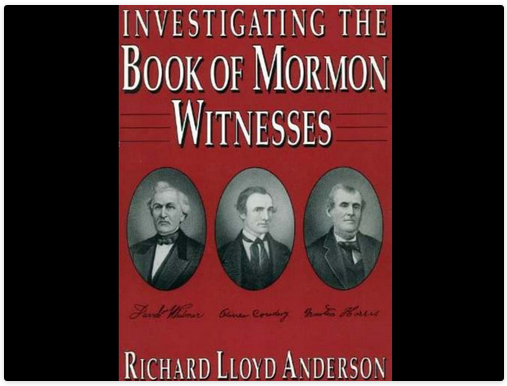
Another book: Opening the Heavens by John W. Welch:
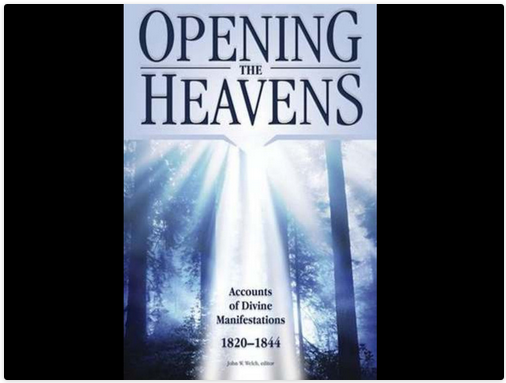
Mark McConkie's Remembering Joseph:
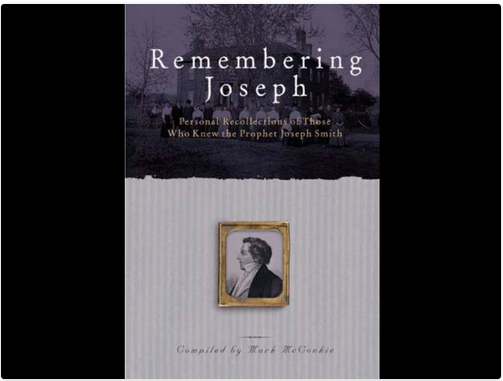
Understanding the Book of Mormon by Grant Hardy:

And I'll just toss in this other one to stand for all the kind of work that was done by the...by at least the "old FARMS", the old Maxwell Institute, in arguing for the ties of the Book of Mormon in striking ways to the ancient Near East, to ancient Mesoamerica and so on.
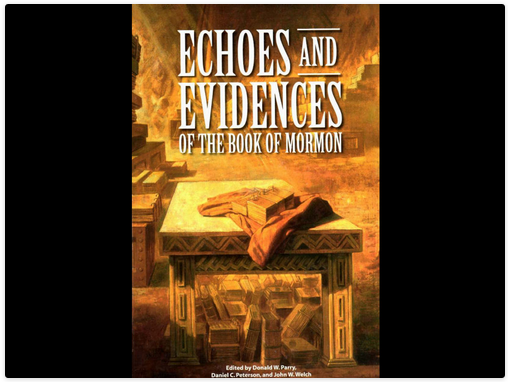
The Gospel of Jesus Christ:
"And when ye shall receive these things, I would exhort you that ye would ask God, the Eternal Father, in the name of Christ, if these things are not true; and if ye shall ask with a sincere heart, with real intent, having faith in Christ, he will manifest the truth of it unto you, by the power of the Holy Ghost." - Moroni 10:4
The Gospel of the Mormon Apologist®:
Purchase and read volumes of unofficial books from unofficial apologists such as Daniel C. Peterson, Hugh B. Nibley, Brian C. Hales, Royal Skousen, John Sorenson, FairMormon, Mormon Interpreter at BYU Studies, Amazon and Deseret Book and you should hopefully get it.
Let me make just a couple more points and then I'll try to shut up. I think that much is dependent on the attitude that we bring to things. These four books I recommend, but I know people that can read them and just brush them aside, especially if you've heard something negative about Joseph Smith and the Church. But, I think when people come to me, and they'll sometimes say...Well, let's put it this way. Suppose one day you hear a shockingly negative report about someone. What effect will the report have upon your opinion of that person? Well, phrased in such a way that the question is essentially unanswerable. Why? Because it matters very, very much whether you had any prior experience with that person - what kind of experience it's been. Suppose the report is the first thing you've ever heard about the person. Well, then that constitutes essentially 100% of what you know, right? And so, if it's a really negative report your initial inclination is to think it's a really bad person. What if it's a person about whom you've heard really bad things? It doesn't change your view fundamentally, but it reinforces. What if it's a person, though, that you've known for forty years. You've known him really well. You've trusted him. He's always been reliable and a person of integrity. You hear this report. You're going to be much more inclined to give him the benefit of the doubt, and to say, "You know, I'd really like to hear what he has to say." I'd say the same thing about Joseph Smith. If you have a strong opinion about Joseph Smith, or of the Book of Mormon, it's going to take a lot more to overturn that favorable opinion than if you know almost nothing, or if you have a negative opinion, or, for some reason, as I think happened in the case of the "Letter to a CES Director," you've come to have a mistrustful attitude. Then almost nothing can be allowed to count. It really matters what you bring to the question with you.
What an incredibly damning indictment of Mormonism, as it indoctrinates its whitewashed image and history in children onward. By the time anyone is exposed to anything critical, they have already endured a childhood of indoctrination, 4 years of seminary, made onerous temple covenants, served a mission and are hopefully married to a believing Mormon who loves them conditioned upon their Mormonism.
The reality is that in life someone that you thought you knew really well can be someone else entirely. We've all read and seen the stories, perhaps even experiencing it ourselves. The wife who just knew her husband was an honest businessman only to receive the shock of her life when discovering that Bernie Madoff stole billions. The family, ward and community of a man that they all looked up to were floored when he was identified, arrested and later convicted as the top downloader of child pornography in Washington. The bishops and stake presidents who swindled millions out of their wards and stakes in their Ponzi schemes. All of the great experiences, "good fruit" and what they brought to the question with them did not change the reality of what these men did in the dark.
The same holds true for Joseph Smith. The Church has sold generations of members a version of Joseph Smith that has been debunked by the documented reality. The Joseph Smith I was indoctrinated by the LDS Church / Correlation in versus the real historical Joseph Smith couldn't be more different.

Again, Peterson continues his gaslighting and "blame the victim" attacks. It's always the fault of those who doubt and those who leave and never the fault of the Church. The Church and its leadership, in Mormon apologist Peterson's universe, are blameless.
Peterson has shifted all responsibility from the Church on to the member who has doubts. Instead of rightly pointing out that the Church has been and continues to be deceptive about its origins and history, Peterson chooses to blame the questioner and doubter for coming "to have a mistrustful attitude."
Earlier in Peterson's presentation, he states:
"My impression is that the author is someone who had leanings in more of what you might call a fundamentalist direction than my own, but he was blindsided by things that he was learning about history and historical difficulties that he had not encountered before. He lost his trust and felt betrayed..."
So, Peterson actually acknowledges indirectly why I would be "mistrustful," but again it's my fault because he bizarrely calls me a "fundamentalist". I was a Joseph Fielding Smith / Bruce R. McConkie Chapel Mormon just like the vast majority of Mormons the last 6-7 decades. This is just Peterson's smug attempt to throw the average Mormon following and aligning with the LDS Church's Correlation under the bus.
Here Peterson argues that you should rely on your "experience" with Joseph Smith and Mormonism in the face of disturbing facts and doubt while attacking those who leave as "mistrustful" and "simply haven't studying enough." The irony that these charges can also be used against apostates of other religions, including cult leaders and cults like Warren Jeffs/FLDS and L. Ron Hubbard/Scientology apparently is lost to Peterson.
I'll just say this, and I'll have done. I don't object to the attempt in the Letter to a CES Director to subject the claims of Mormonism to reasoned examination. I just don't think the effort went nearly far or deep enough. An adequate examination of Mormonism should take into account the fact, noted by the great German social theorist Max Weber, that Joseph Smith "resembled, even in matters of detail, Muhammad and, above all, the Jewish prophets." It should explain the non-Mormon Old Testament scholar Lester Grabbe's contention that an understanding of Joseph Smith can shed valuable light on prophecy in ancient Israel. It should make at least an attempt to deal with the amazement of the Finnish Lutheran scholar Heiki Risan expressed in an article published some years ago in the [name of foreign language journal] (a commonly read magazine around these parts) at the uncanny way in which Joseph Smith hit upon salient issues and problems in ancient scriptural texts and moved to resolve them. It should engage with the Catholic philosopher Stephen Webb's admiration in his 2013 Oxford University Press book "Mormon Christianity: What Other Christians Can Learn from the Latter-day Saints", for the materialist metaphysics of Mormon thought. Professor Webb argues that the idea of a permanently embodied Christ, and an embodied God, has a great deal to offer the wider Christian world. "One can think what one wants," wrote the late German ecclesiastical historian Ernst Benz, "of the doctrine of progressive deification in Mormonism. But one thing is certain: With this anthropology, Joseph Smith is closer to the view of Man held by the ancient church than the precursors of the Augustinian doctrine of the Original Sin were, who consider the thought of such a substantial connection between God and Man as the heresy parexsalonce." In the examination of Joseph Smith that's going to be fair, [one] should confront the admiration of the Yale University literary scholar Harold Bloom for Joseph Smith. "Other Americans have been religious makers," wrote Bloom, "but none of them has the imaginative vitality of Joseph Smith's revelation. A judgment one makes on the authority of a lifetime spent in apprehending the vision of great poets' original speculators. So self-created was he that he transcends Emerson and Whitman in my imaginative response and takes his place with the great figures of our fiction. So strong was Joseph's act of reading the Bible," Bloom says, "that it broke through all the orthodoxies and found its way back to elements that Smith rightly intuited that had been censored out of the archaic stories of the Jewish religion."
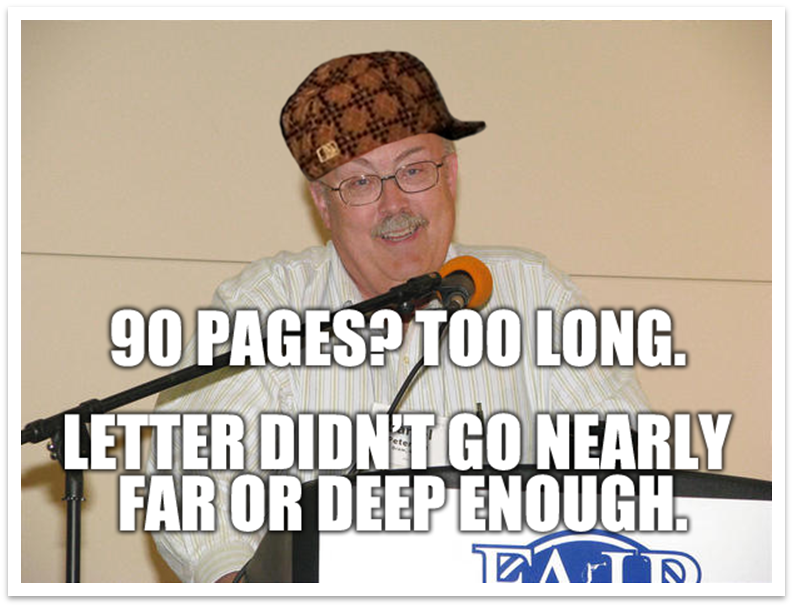
Again, Peterson completely ignores my thousands of detailed rebuttals and debunkings while demonstrating his ignorance on the background and purpose of the CES Letter: a letter to a CES Director asking for help with the LDS Church's truth crisis.
As for the rest of Peterson's above rambling? I have no idea what Peterson's point is. Something about Joseph Smith and Muhammad and Jewish religion?
The shallow con artist implied by the Letter to a CES Director doesn't seem even remotely adequate or worthy of such comments from respected, even eminent, non-Mormon scholars, which is much more a reflection on the Letter than on Joseph Smith. And what of Joseph's teaching on exaltation, listen to what the Dominican Catholic priest Jordan Vajda has to say at the end of his 1998 thesis at the Graduate Theological Union in Berkeley: "What has resulted from taking another look at the GodMakers? The Mormons are truly god makers, as the doctrine of exaltation explains. The fullness of human salvation means becoming a god, yet, what was meant to be a term of ridicule has turned out to be a term of approbation, for the witness of the Greek Fathers of the Church is that they also believe that salvation meant becoming a god. It seems that if one's soteriology cannot accommodate a doctrine of human divinization, then he has, at least implicitly, if not explicitly, rejected the heritage of the early Christian Church and departed from the faith of first millennium Christianity. However, if that is the case, those that would espouse such a soteriology also believe, in fact, that Christianity from about the second century on has apostatized and gotten it wrong on this core issue of human salvation. Thus ironically, those who would excoriate Mormons for believing the doctrine of exaltation actually agree with them that the early Church experienced a great apostasy on fundamental questions. And the supreme irony is that such persons should probably investigate the claims of the LDS Church," (this coming from a Catholic priest), "which proclaims that from within itself can be found the restoration of all things."
So, Joseph Smith was a prophet because he really liked the idea of exaltation and included it in his theology?
Peterson is big on the idea that "exaltation" is an ancient doctrine or teaching that was restored by Joseph Smith and thus this "restoration" is a testament to Joseph's calling as a prophet of God. Peterson even wrote an article on this topic entitled "Defending the Faith: Joseph Smith's restoration of 'theosis' was miracle, not scandal". A direct rebuttal to Peterson's article can be read here.
I never said that Joseph Smith was shallow nor do I believe he was shallow. This is a strawman on the part of Peterson.
I do, however, stand by my position that Joseph Smith committed fraud repeatedly over two decades of his life as the multitude of evidence for fraud on the part of Joseph Smith is thoroughly and conclusively verifiable.
We see fraud in Joseph Smith's practice and 10+ years of denials on his polygamy and polyandry while he was practicing in the dark.
We see blatant and demonstrable fraud in Joseph's Book of Abraham.
We see fraud in Joseph's backdating and retrofitting of the Priesthood restoration.
We see fraud in Joseph's antiquity claims of the Kinderhook Plates hoax.
We see fraud in the multiple conflicting and historical contradictory First Vision accounts.
We see fraud in Joseph's treasure hunting activities as well as in his use of the same treasure hunting method for "translating" the Book of Mormon.
We see fraud in the Book of Mormon with its serious anachronisms, presence of 1769 KJV errors and presence of 17th century italics.
We see fraud in Joseph's "Inspired" Version of the Bible.
We see fraud in Joseph's Kirtland Safety Society (Bank) scandal.
The list continues.
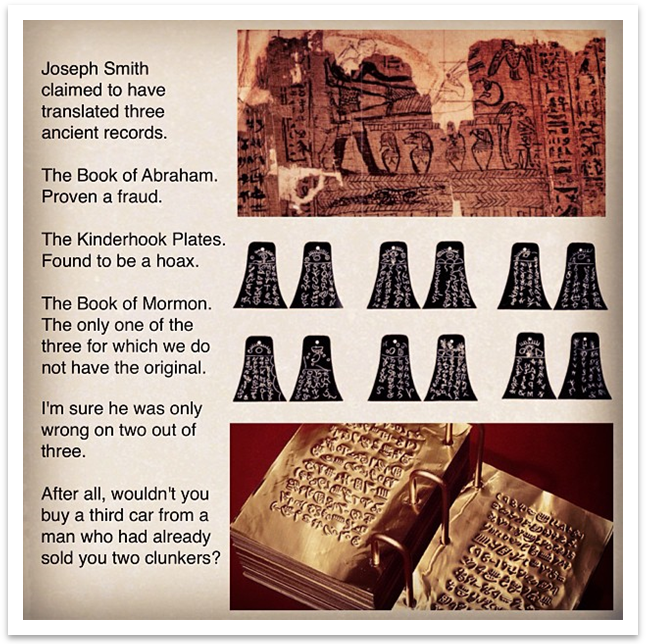
I appreciate top Mormon apologist Daniel C. Peterson publicly sharing his opinions and lack of understanding of the CES Letter, its background story and its purpose. I believe that members and investigators deserve to hear what both sides have to say before coming to their own conclusions.
This is why I have made it a top priority to be completely open and transparent in my work. I share live direct links on my website to FairMormon and apologetic attacks. They don't. They instead censor and keep their audiences in the dark about rebuttals and challenges to their claims.
Ask yourself which party here is afraid of the data, truth and transparency?
At the end of the day? Daniel C. Peterson and FairMormon's opinions and pet theories are no more legitimate and official than the pet theories of that weird High Priest guy that everyone rolls their eyes to in Sunday School and Priesthood.
The Church is improving in the transparency department and has released in 2013 and 2014 a few essays on the issues and problems. Fortunately, this direction and the essays are making FairMormon, Daniel C. Peterson and their buddies obsolete as the Church overrides them with official answers. The essays are not comprehensive and they gloss over and ignore a few important facts but it's still a step in a more transparent direction. Several of the essays contain astounding concessions that have shocked and continue to shock Chapel Mormons (see Race and the Priesthood, Translation and Historicity of Book of Abraham, Book of Mormon and DNA Studies and Book of Mormon Translation). You can access all of the direct links to the Church's new essays as well as critical analyses at www.cesletter.org/essays.
Of course, Peterson completely ignored these very important official essays in his presentation attempting to "address" the problems raised in the CES Letter. After all, why tell us what the one and only true Church of Jesus Christ has to say about the issues when you can instead share what the unofficial Gospel of the Mormon Apologist® has to say instead?
The Bizarre Gospel of the Mormon Apologist®
The simple fact that Mormon apologists keep missing is that many of their answers are like a band-aid on a head wound. They are not appropriate and entirely ineffective. To imply that those who are honestly seeking should just hang in a little longer, read a few more books, study harder and put their faith in unofficial and contradictory apologetic arguments full of Clintonesque linguistic tricks that redefine simple words like "horse," "translate," and "steel" is just absurd.
Mormon Apologists Contradict Each Other and Themselves:
Yet, in apologist Peterson's universe, I'm one-sided for not granting contradictory unofficial Mormon apologetics legitimacy and authority by not including its opinions and theories in my letter to the CES Director seeking official answers to the issues and problems.
Mormon apologists' stock and trade is in peddling possibilities. If you ask for evidence that something is as claimed by the Church when all available evidence suggests the contrary, they only have to wave their hands and conjure up a possibility - any possibility - that could be true. They puff up their positions by borrowing a little bit from selected scholars, self-reference their friends who use the same flawed approach and carefully select which scientific tools they will employ. Along the way they demean scholars who don't agree with them, cast doubt on "so-called" scientific methods that do not support their desired conclusion and smear anyone who stands between them and their pre-determined objective. This process is bankrupt from the start because it ignores the first and most important rule of the scientific method: start with a hypothesis, not a conclusion. Mormon apologists always start with the assumption that the claim they seek to prove is a given truth. They then work their way backwards, sifting through all possibilities until they find something - anything - that may have been.
Peterson admits as much in the LDS Church News regarding the purpose of Mormon apologetics:
"to help faltering Church members and to help interested observers see enough plausibility in the Church's claims to take the gospel seriously or to overcome their doubts." (Emphasis mine)
In Mormon apologetics, it's always about the trees and never the forest. It's as if all of the issues and problems are only a single problem and never a series of problems. In mathematics, it would look like 1x1x1x1x1x1x1x1x1x1=1. Despite all of the problems, all is well and the Church is still true because it's, in the apologist's universe, only one problem. Critics see the forest from the trees and do the math as 1+1+1+1+1+1+1+1+1+1=10. Thus, the problems carry great weight against the foundational truth claims of the LDS Church.
The following article illustrates how Mormon apologetics work and what the tools of the trade are: Inside the Minds of LDS Apologists. We see many of these tools being utilized by Peterson in his FairMormon presentation.
Parallels Between Mormon and Santa Apologists:
Every time I hear someone provide arguments against the existence of Santa Claus I just roll my eyes. They never have anything original or new.
None of you ex-Santa believers have any new or original arguments! It's all been addressed and answered long ago. You simply jumped ship and didn't study enough.
We're in a time of upheaval and revolution within Mormonism. The ship of Mormonism has collided with the Internet iceberg and the passengers are now beginning to wake up.
The reason we jumped ship and many others continue to jump off the sinking ship of Mormonism, Mr. Peterson, is because we have studied enough.

Born and raised in Southern California, Jeremy is a seventh generation Mormon of Pioneer heritage who reached every Mormon youth milestone. An Eagle Scout, Returned Missionary, BYU alumnus, Jeremy was married in the San Diego Temple with expectations and plans of living Mormonism for the rest of his life.
In February 2012, Jeremy experienced an awakening to the LDS Church's truth crisis, which subsequently led to a faith transition that summer. In the spring of 2013, Jeremy was approached and asked by a CES Director to share his questions and concerns about the LDS Church's origins, history, and current practices. In response, Jeremy wrote what later became publicly known as the CES Letter (originally titled Letter to a CES Director).
The CES Director responded that he read the "very well written" letter and that he would provide Jeremy with a response. No response ever came.
“I believe that members and investigators deserve to have all of the facts and information on the table...to be able to make a fully-informed and balanced decision as to whether or not they want to commit their hearts, minds, time, talents, income and lives to Mormonism. Anything less is an obstruction to the free agency of the individual.”
- Jeremy Runnells
It takes a lot of time, effort, and money to provide quality information in a quality way. It also takes a lot of resources to help those who have questions and who are trying to liberate themselves and their loved ones, while keeping their dignities intact. We want to be in the position to help, and you can help make that possible.
Your generous donations are tax deductible and will go a long way in helping us to continue to help the honest-in-heart seekers.

CES Letter Foundation is a 501(c)(3) nonprofit organization whose mission it is to liberate and empower doubting LDS individuals and mixed-faith marriages.